 ALBERTA / FOOD & DRINK / RECIPES JUNE 2024
The Buzz about Bourbon | Dinner for Dad | Belgian Beer | Edible Flowers
ALBERTA / FOOD & DRINK / RECIPES JUNE 2024
The Buzz about Bourbon | Dinner for Dad | Belgian Beer | Edible Flowers



















 Laphroaig® 10 Year Old Single Malt Scotch Whisky, 43% alc/vol. ©2024 Laphroaig Import Company, Chicago, IL
Laphroaig® 10 Year Old Single Malt Scotch Whisky, 43% alc/vol. ©2024 Laphroaig Import Company, Chicago, IL








June 2024 | Culinaire 3 contents departments 6 Salutes and Shout Outs News from Alberta’s culinary scene 7 Book Review BBQ Pit Boys “Book of Real Guuud Barbecue” and The Krause Berry Farms Cookbook 8 Off The Menu Thai Sa-On’s Tom Kha Gai Thai Coconut Chicken Soup 10 Chefs’ Tips and Tricks Meat your maker! 38 Making the Case …for warm weather sippers 40 Etcetera What’s new? 42 Open That Bottle With Sky McLean of Basecamp Resorts It’s after May Long, so summer must be here. We let slip to photographer Katarzyna Kowalewska that we were thinking of blue skies and bourbon for our June issue, and look what she came back with. Thanks so much to Katarzyna for perfectly capturing our thoughts in this outstanding photograph! ON THE COVER Volume 13 / No. 2 / June 2024 14 Edible Flowers in the Kitchen There may already be edible flowers in your pantry by Morris Lemire 18 Chicken Sandwich Dilemma Open to any combination of ingredients that tickles your fancy! by Natalie Findlay 20 From Waste to Resource Do you ever think about what happens to the chopsticks you use at the restaurant? by Lucy Haines 22 Deep and Delicious Detroit style pizza by Renée Kohlman 24 Old Styles, New Tricks Belgian beer and its dynamic culture by Keane Straub 28 The Buzz about Bourbon America’s “Official Spirit” is celebrating 60 years! by Linda Garson 30 June Spirits A bourbon roundup! by Tom Firth and Linda Garson 32 The Bourbon Boom Increasing in popularity, Bourbon is perfect for cocktails by Linda Garson 35 Beer Styles Getting the Love they Deserve Five lesser-known styles getting all the attention by David Nuttall 20 14 24
It’s here!
Idon’t want to jinx it, but it’s after May Long, so can we plant our pots yet?
I love having pots of herbs and leaves on my 12th floor kitchen balcony, and to be able to just open a door and have leafy salad at my fingertips, and herbs for flavouring other dishes (although I must say, fresh herbs in a leafy salad make me so happy!) reminds me of the kitchen garden we used to have (and the chickens too, just for eggs!) at our smallholding, nine miles north of Manchester, in England.
We used to grow new and maincrop potatoes too, beans and squashes of all types (well it does rain a bit there, so many a time our courgettes looked like marrows!) but funnily we didn’t know then that we could stuff the flowers and fry them, and they’re one of my favourite things to eat now when I’m in Italy and when I see them on a menu here! This issue, we have an article on eating all

sorts of edible flowers, and it’s surprising that we don’t realise that some of what we eat are flowers.
Because it was often raining, we didn’t BBQ much then (the same amount of days I could get the top down on my Miata, maybe 12-20 a year?) and we certainly didn’t drink bourbon (well we were only 200 miles from Scotland), but I have found a new respect and admiration for it after a visit to Louisville in Kentucky, and I hope you’ll join me in raising a glass this month!
Cheers,
We loved this email from Candy W, thanks for making our day!
Dear Linda,
Thank you to you and all the contributors to this lovely edition of your magazine! The Cabane à Sucre was the inspiration for a house gift for new friends who invited us to dinner. We bought a 1 litre jug of Dark Maple Syrup from Crossroads Market on Saturday. Culinaire helped with the selection by letting us know that its flavour was more pronounced than the Amber, but not as strong as the Very Dark. I have put a copy of this edition of Culinaire in the gift bag along with the jug of maple syrup. These two items make a simple, elegant gift. Cheers!
Linda, Editor-in-Chief

Candy W


LETTER FROM THE EDITOR
Alberta / Food & Drink / Recipes
Editor-in-Chief/Publisher
Linda Garson
linda@culinairemagazine.ca
Managing Editor
Tom Firth
tom@culinairemagazine.ca
Multimedia Editor
Keane Straub
keane@culinairemagazine.ca
Assistant Editor
Quinn Curtis quinn@culinairemagazine.ca
Design
Kendra Design Inc
Contributors
Quinn Curtis, Natalie Findlay
Lucy Haines, Dong Kim
Renée Kohlman, Morris Lemire
David Nuttall, Keane Straub
Our contributors

David Nuttall
David has worked in liquor since the late 1980s. He achieved his Beer Judge Certification in 2012, and is the head judge for Calgary International Beerfest, as well as judging the Alberta Beverage Awards and Alberta Beer Awards. He has appeared on radio, television, and in the movie Aleberta: Our Beer History. He is also a freelance writer for print and online, speaker, and has run Brew Ed beer courses since 2014. Follow him @abfbrewed.


Contact us at:
Culinaire Magazine #1203, 804–3rd Avenue SW Calgary, AB T2P 0G9 403.870.9802
info@culinairemagazine.ca @culinairemag @culinairemag @culinairemag facebook.com/CulinaireMagazine

Katarzyna Kowalewska
Katarzyna is originally from Poland, and she has found her home here in Alberta. It wasn't until she married a chef that she found her passion for food and beverage photography, and now works as a freelance photographer, creating drool-worthy images of food and vibrant drinks. Her equally important love is portrait photography. Katarzyna is also passionate about baking, a big-time bookworm, and crazy about puzzles.

For subscriptions, competitions and to read Culinaire online: culinairemagazine.ca
Dong Kim
A freelance photographer and consultant, Dong splits his time between Edmonton and Calgary. Although he shoots a wide range of subjects, his passion lies in photographing food and capturing stories from the food community. An avid traveller whose itineraries often revolve around learning about a culture through its culinary scene, Dong shares many of his travels and food encounters on Instagram at @therealbuntcake.
Culinaire Magazine acknowledges that we live, work and play on the traditional territories of the Blackfoot Confederacy (Siksika, Kainai, Piikani), the Tsuut'ina, the Îyâxe Nakoda Nations, the Métis Nation (Region 3), and all people who make their home in the Treaty 7 region of Southern Alberta. We are committed to support Indigenous chefs and amplify their voices to bring awareness of the food and culture of the First Nations.
LUXURY WINE AND CULINARY TOUR OF ALSACE & CHAMPAGNE
September 21 - October 2, 2024
From the 13th century historic city of Colmar in Alsace to the world-renowned, grand wine regions of Champagne, come and experience the real France!
This comprehensive tour includes:
• Guided private visits to wineries of Alsace and Champagne
• Food treasure hunt in Colmar to explore the city and its culinary specialties
• Optional two days in Paris
• Champagne sabering class
• Premium wine tastings
• Lunches and dinners with wine
• Plenty of opportunities for shopping
• Fully air-conditioned transfers and transport each day
• and lots lots more....

For de tails, contact Linda: 403-870-9802
linda@culinairemagazine.ca
All Trademarks presented in this magazine are owned by the registered owner. All advertisements appearing in this magazine are the sole responsibility of the person, business or corporation advertising their product or service. All content, photographs and articles appearing in this magazine are represented by the contributor as original content and the contributor will hold Culinaire Magazine harmless against any and all damages that may arise from their contribution. All public correspondence, which may include, but is not limited to letters, e-mail, images and contact information, received by Culinaire Magazine becomes the property of Culinaire Magazine and is subject to publication. Culinaire Magazine may not be held responsible for the safety or return of any unsolicited manuscripts, photographs and other materials. Reproduction of this publication in whole or in part without written consent from Culinaire Magazine is strictly prohibited.
Proudly printed in Alberta by Burke Group.

Congratulations to Fratello Coffee Roasters who are celebrating 50 years in the coffee industry. Cam Prefontaine founded Fontaine Beverages in 1974, with sons Chris and Russ taking over in 1997 and continuing the community connection, values, and innovation of their family legacy, roasting, and brewing their high-quality, ethically sourced coffee. fratellocoffee.com
Congrats too to Scott Downey and Jillian Fonteyne of Edmonton’s The Butternut Tree, who have purchased the elegant, yet casual, The Marc. They promise to continue the classic French bistro as we’ve always known it, and we are in no doubt it’s in very good hands! themarc.ca
Applications are open for the 6th edition of S.Pellegrino’s Young Chef Academy Competition. Until June 19, chefs under the age of 30 can submit their signature dish recipe that exemplifies their skills, creativity, and vision. sanpellegrinoyoungchefacademy.com
Charcut’s second location is now open in Calgary’s University District, and almost half the menu is dedicated to ‘The Butcher (Connie DeSousa’s) Daughter, with vegetable dishes and small plates. Of course there’s more than plenty to satisfy meat lovers too - a salumi cart (the first we’ve heard of!) which they bring to you and cut the sausages and other housemade charcuterie tableside – including whole pig mortadella with pistachios, (they went through

four whole pigs in their first 11 days), Portuguese Linguiça, Finocchiona, Pepperoni Salumetti, as well as whipped fresh cheese and accompaniments. Chef Jack Coetzee is in the kitchen, and we really enjoyed his Fritti Spuntini –fried snacks of ham croquettes, fried mozzarella, and clam misto. And his shaved, salted, zucchini salad with fresh lemon, chilis, mint, and chopped pistachios is a must-try; the balance of flavours and textures is so clever! Connie and John have got it right again, with exemplary flavours, and meats - they’re right to be proud of their charcuterie, sausages, salumi - everything is really well executed. Closed Mondays, charcut.com
In addition to Nisku and Brooks, Lobster Mobsters have opened a third location in Edmonton’s former Cheesecake Café at 17011 100 Avenue. Brothers Devin and Colby Campbell are from PEI, and after moving to Alberta, brought us fresh East Coast seafood (and the hospitality too), selling out of the backs of their trucks and at farmers markets. The new store sells fresh and frozen seafood as well as their made-to-order lobster rolls to takeout. thelobstermobsters.com
Bar Gigi is open in the former Halibut Hut spot on Calgary’s Edmonton Trail at 336 9 Avenue NE, and we couldn’t be more pleased for friends and owners, Sandro Chinea, Jaden Kanomata, and Kayla Blomquist, to see their dream come true: it’s a success straight out the gate. With only

13 items on the menu, you know every one of them is going to be good – and they are extremely good - controlled yet accessible, creative and interesting, elegant yet simplistic, with no rules: just taking everyday ingredients and elevating them. Try a couple of plates and you’ll want to come back and try more – we know we did! A lovely, curated cocktail, mocktail, wine, and beer list too. This little 22-seat spot (with an amazing signature mosaic floor) is going to be busy, so make sure to reserve. From 5 pm, closed Tuesday/Wednesday.
Edmonton has its first Yemeni café! Mokha Coffee House is now open in Griesbach, at 5344 Admiral Girouard Street, with two very attractive and beautifully decorated, bright and spacious levels where they’re brewing up Mofawar (Yemeni coffee), Adani - traditional spiced Yemeni tea, and refreshing iced Mojitos, to accompany their freshly baked pastries and cakes. Seven days, 9 am till midnight.
Banff has a new hotel, and it might take you by surprise! The result of a $30 million renovation of Banff’s original motor hotel, the 60-year-old Voyager Inn, Moxy Banff certainly stands out from the crowd. Décor is vintage mid-century modern: orange psychedelic carpet in the corridors, and retro room fixtures - and when you’re hungry, the all-day menu of flatbreads, brisket poutine, sticky Korean chicken wings, sandwiches, meatballs, and more are served from a restored 1966 VW food truck. There are 109 rooms
6 Culinaire | June 2024 SALUTES & SHOUT OUTS
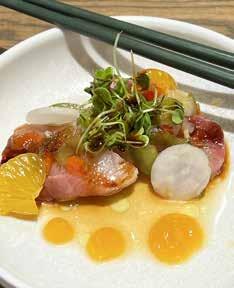
and they’re unconventional too, with two toe-to-toe queen beds. Some also have double bunks, kitchenettes, and lock-offs that make two rooms into one. The central courtyard leads off from the bar, it’s a place to lounge, socialise, sip your complimentary cocktail, or take a dip in the hot pools. Or hang around the Voyager Room and choose from more than 200 vinyl LPs and classic films. Moxy Banff is groovy and playful for fun-seekers and the young at heart –if not in age! 555 Banff Avenue.
“I’ll see you at the office”– but not that office – THE Office! The old Metropolitan Grill on Calgary’s 8 Avenue SW has had a total renovation, and is now a chic restaurant serving California Cabo-style (and a little bit of Asia too) cuisine, with a healthy tequila list, ‘cervezas’, margaritas, mocktails, plenty of glass pours, and one-litre jugs of Sangria too. There’s something for everyone on Chef Ryan Blackwell’s menu, the dishes are masterly done, with a terrific balance of acidity and sweetness, spice, and umami – we wanted to lick the plate of our Hamachi Crudo! There’s a raw bar, tacos and baos, salads, amped-up pizzas, plenty of steak choices, chicken and seafood dishes, as well as gluten-free and veggie options. The Boardroom is a private space for 12 people, and a 100-seat patio is coming soon. The Office is a completely new brand, 100 percent locally owned, and it’s busy - so make a reso! Seven days 11 am - late, theofficerestaurantandbar.com
BBQ Pit Boys “Book of Real Guuud Barbecue”
By the BBQ Pit Boys, Firefly Books $30
Yes… sigh… it’s “Guuud” with three U’s. The Barbecue Pit Boys are YouTube sensations with over a billion views on their channel, so they might know a thing or two about… good barbecue. Messy, flavourful, smoky, barbecue that they do so damn well in the USA, a carnivore’s dream with over 100 recipes from chicken wings to mussels – pies to desserts it’s all here.
The common thread that appears here is that of intensely flavoured, primarily meat-centric, carnivorous dishes, but second to that, things are really on the messy side. You’ll want to stock up on the napkins if you are making your way through this one. Finally, there is a fine depth in the BBQ Pit, lots and lots of beef, but also kebabs (p.96), rabbit (p.130), Cornish hens (p.164), clams (p.180), lambs (p.120-126), and venison (p.128), with only a small representation of the sides and salads. I’d warrant that if it

“could” be barbecued, it “should” be in your new, “guuud” book of barbecue. A solid book for the aspirational grill god, or someone looking for some excellent recipes or dishes to share.
Try to have a salad this summer too… you know – for some balance.
The Krause Berry Farms Cookbook “Sweet and Savoury Recipes from the Fraser Valley’s Famous Farm and Bakery.”
By Sandee Krause, Appetite by Random House $38
Krause Berry Farms and Estate
Winery started in 1974 with one acre of strawberries, and became a U-pick. Now, 50 years later, Sandee and Alf Krause have 200 acres of mixed produce, a market, a bakery, four kitchens, a winery – over 200 staff at harvest time and more than 350,000 visitors a year.
And they make and sell more than 100 prepared foods such as jams, pies, soups, cakes, and cookies, with produce they grow on the farm. It makes you feel tired just thinking about it, doesn’t it?
Evidently many guests ask for the recipes for their favourite dishes, and now Sandee Krause has obliged, and compiled well over 100 of them for all of us to be able to make at home.
So much to tempt us here in every one of the nine chapters, starting with Breakfast and Brunch, through Soups, Mains, and then four chapters on breads, cookies, cakes, pies, and more baked goods, ending with drinks and staples.

The stories are captivating, and we love that Krause had added a “Wink” to many of the recipes with tips, and suggestions for variations.
Having read this beautiful book, I not only want to try my hand at making many of these delicious-sounding (and looking) cooked and baked goods, but now I want to visit the farm too!
June 2024 | Culinaire 7 BOOK REVIEWS BY TOM FIRTH AND LINDA GARSON
Thai Sa-On’s Tom Kha Gai
BY LINDA GARSON
When we run Vine & Dine events, the pairing dinners are regularly multiple courses each paired to complement the flavours.
We’re proud that we’re known for our perfect and complementary pairings, and we’re usually spot on as we’re very well versed in pairing rules and theories.
However, while most of it is done in our heads, and we’ve been doing it for more than 18 years now, we almost never get to try the food first, and if we do, we rarely get to try it with any beverages.
Last month, we ran three pairing dinners at Thai Sa-On and of the six dishes there was one that almost everyone commented on – and surprisingly a soup. This Tom Kai Gai is made with chicken, mushrooms, lemongrass, lime, and coconut milk, and is light with a fresh zing to it, and a little spice too from the chili.
On two evenings we paired it with a lovely lightly oaked chardonnay from California, and on the third evening we had a winemaker from Le Marche, in Italy, with us and we paired it with her pecorino. Both were excellent pairings and a lot of people asked for the recipe – including our Italian and Californian winemakers!
Thanks very much to Thai Sa-On’s new owner, Patcharin Smith, for generously sharing her recipe, and for three great evenings at the restaurant that were enjoyed by so many people!
Thai Sa-On’s Tom Kha Gai
Serves 4
400 g chicken breast, sliced thin
100 g shimeji mushrooms (or substitute oyster or button mushrooms)
1 small can (400 mL) coconut milk
1¼ cups (300 mL) chicken stock
5 tsp sugar
2 tsp garlic, crushed
1½- 2 tsp fine sea salt

1 tsp crushed black pepper
5 pieces galangal, cut into small strips
5 pieces lemongrass, cut into 5 cm lengths (use the bottom half of the stick)
2 kaffir lime leaves, torn by hand into smaller pieces
3 Tbs (45 mL) lime juice
5 cherry tomatoes, cut into half
½ tsp Thai chili, crushed (optional)
2 spring onions, chopped, for garnish Cilantro, for garnish
1. Put the first eight ingredients (chicken, mushrooms, coconut milk, chicken stock,
sugar, garlic, salt and pepper), into a soup pot and bring to the boil.
2. Lower heat and add galangal, lemongrass, kaffir lime leaves, lime juice, tomatoes, and chili (if using). Let cook for one more minute.
3. Garnish with spring onions and cilantro as desired.
If there’s a dish in a restaurant in Alberta that you’d love to make at home, let us know at culinairemagazine.ca, and we’ll do our very best to track down the recipe for you!
8 Culinaire | June 2024 OFF THE MENU

Make us part of your new home. Customers are free to purchase natural gas services or electricity services from a retailer of their choice. For a list of retailers, visit ucahelps.alberta.ca or call 310-4822 (toll-free in Alberta).
Meat Your Maker
BY KEANE STRAUB
PHOTOS BY DONG KIM
Summer in Alberta is pretty much reserved for grilling, and that usually means steaks, in whatever cut you fancy. But not everyone has access to a grill (or can fight dad for control of it), and
For Daniel Ducharme, owner and executive chef of St. Albert’s Riverbank Bistro, cooking is all about flavour and culture. “I’ve worked with so many talented people from all over the world throughout my career, it’s impossible not to soak in their culture and food, and apply these learnings through my cooking,” he explains.
The menu at Riverbank is classic, with dishes like the Fire Grilled Salmon Filet, but there's a few twists thrown in like Chef’s favourite Korean Fried Chicken. The Short Ribs, however, rank high for both Chef Daniel and guests at Riverbank Bistro.
“I learned good braising practices from Steve Buzak at the Royal Glenora Club,” he says, “and I feel as though I have nailed the technique. I know that when it hits the table, people have already begun to eat with their eyes, and the dish does not disappoint.”
There are no magic tricks when it comes to recreating this dish at home, but it does require time and patience. “Season the broth well, use fresh ingredients, and clean as you go! I’ve been guilty as charged of the latter myself.”
Braised Beef Short Rib topped with Demi Glacé
Serves 4
2¼ kg chuck flats
To taste salt and pepper
Oil for sautéing
2 celery stalks, chopped
2 carrots, chopped
1 large onion, chopped
6 garlic cloves
6 thyme sprigs
4 rosemary sprigs
sometimes it’s just nice to change things up a bit.
So, for this month’s Chef’s Tips, we reached out to Alberta chefs to give us their best when it comes to meat-centric dishes. Like always, they
knocked it out of the park sending recipes for chicken, pork, boar, and beef. And in most cases the grill – and dad – gets a rest. Tell them not to worry though, there’s plenty of summer to come and barbecues to be managed.

4 bay leaves
½ cup (125 mL) dry red wine
2 cups (500 mL) beef stock
1. Trim the beef of any undesirable fat or connective tissues. Season liberally with salt and pepper.
2. Sear the beef in a Dutch oven on medium high heat. Remove the beef and set aside.
3. Sauté your mirepoix (celery, carrots, and onions), and add the garlic, thyme, rosemary, and bay leaves. Sauté for 3-5 minutes or until golden brown in colour.
4. Deglaze the pan with red wine.
5. Add the beef chuck back to the

pot, add the beef stock and ensure the pieces of meat are submerged in stock. Bake covered in a 350º F oven for approximately 3½ hours.
6. When it is cooked, DO NOT remove the beef from the liquid. Allow it to remain in the liquid just prior to serving. Serve with your favourite vegetable, herbed goat cheese, and mash potatoes.
10 Culinaire | June 2024 CHEF’S TIPS & TRICKS
Fresh, seasonal ingredients are the main driving factor for Chef Dwayne Ennest’s cooking, and when it comes to meat, Alberta offers an abundance of options. “They’re typically of great quality,” he explains, “just use a good rub or your favourite herbs and keep it simple.”
As the executive chef at Calgary’s Vintage Chophouse, it’s dishes like the Duck Tart with wild mushrooms, truffle and friulano cheese, and the grilled Lambtastic rack of lamb with classic peppercorn sauce that are Chef Dwayne’s favourites. But it’s the rustic nature of simple, traditional dishes that often steal the spotlight, and can often be created with little stress.
Chef Dwayne shares with us this recipe for Grilled Wild Boar Sausage with White Bean Cassoulet. “Cassoulet is a great classic French country dish, and you can really make it your own based on how you like to season it and the ingredients you choose,” he adds. Here, he chooses rich and buttery cannellini beans, perfect for an early summer meal.
Grilled Wild Boar Sausage, with White Bean Cassoulet, Roasted Morels, Taber Corn Créme Fraichè, and Salsa Roja
Serves 6 or generous portions for 4
White Bean Cassoulet
5 shallots
225 g butter
150 g wild boar bacon, cubed
2 Tsp chopped rosemary
2 Tsp chopped sage
1 tsp sumac
4 cloves confit garlic, squeezed from husk
1 cup (240 mL) white wine
6 cups (1½ L) chicken stock
1 tsp Aleppo chili flakes
4 cups cooked cannellini beans
2 cups (500 mL) heavy cream
To taste salt
3 wild boar sausages, grilled rare and sliced
1. Sauté shallots with butter until golden brown, add bacon, rosemary, sage, sumac, and garlic. Sauté till bacon is cooked.

2. Deglaze pot with white wine and add chicken stock. Reduce by half.
3. Add Aleppo chili flakes, beans, and cream, and bring to a simmer. Cook till sauce coats a spoon and beans are soft, season with salt.
Sweet Corn Lime Crème Fraîche
2 cups sweet (or Taber) corn
1 tsp garlic shallot purée
3 limes, zest and juice
2 cups (500 mL) crème fraîche
To taste salt and pepper
1. Pan roast corn with garlic shallot purée until corn has a bit of colour.
2. Cool corn mixture completely and then mix with lime juice and zest, crème fraîche, and season to taste with salt and pepper.
Salsa Roja

1 red onion
2 sweet peppers, seeded and cut in half
1 poblano pepper, seeded and cut in half
3 vine ripe tomatoes
2 jalapeños
Water
1/3 cup (80 mL) lime juice
1 cup cilantro
I tsp sea salt
1. Put all the ingredients apart from the lime juice and cilantro into a pot with water to cover and bring to a boil. Boil for 3 minutes.
2. Remove from water and place in a blender with the lime juice and cilantro. Blend until smooth and season with sea salt.
June 2024 | Culinaire 11
The concept of ‘nose-to-tail' eating is a driving philosophy in Chef Jack Coatzee’s culinary craft. Combined with the desire to create relationships with local farmers and producers, and experience that spans the globe, he brings a unique style to Calgary’s CHARCUT University District, blending Italian and Portuguese cuisine with Alberta’s best ingredients.
The freshness of the Shaved and Salted Zucchini salad, and the rich, buttery herbs of the Mediterranean Branzino vie for top spot in Chef Jack’s heart, but it’s this dish of Portuguese Chicken Livers with Charred Sourdough that wins out.
“Growing up, my dad’s best friend was Portuguese, and he would make this dish. This dish reminds me of home, friends, and family, sharing stories and breaking bread with loved ones.”
While all the ingredients can be found at farmers’ markets, when it comes to the chicken livers, Chef Jack recommends doing a bit of research with the butcher. “Call ahead to make sure they have them fresh and available.” As with all cooking, bring things back to basic. “Taste as you go and cook with love, and you will be sure to create a successful dish.”
Chef Jack's Piri Piri of Chicken Livers on Charred Sourdough Toast
Serves 4
1 Tbs butter
1 Tbs olive oil
½ large onion, finely chopped
2 cloves garlic, minced fine
450 g chicken livers, cleaned and trimmed of excess fat
½ cup red shepherd pepper (or other sweet red bell pepper), diced
To taste salt, about 1 tsp
1 tsp cracked black pepper
2¼ Tbs (34 mL) tomato paste
½ Tbs (7 mL) Worcestershire sauce
1½ tsp cumin
1½ tsp smoked paprika
1 Tbs hot piri piri sauce, or sweet if you don't like it hot
¼ tsp fresh oregano leaves
1 lemon, juiced
½ cup (125 mL) heavy cream
1 oz (2 Tbs) brandy
Fresh parsley, for garnish
Charred sourdough with olive oil, to serve

1. Heat butter and olive oil in a large skillet over medium heat. Sauté onions for 3 minutes or until translucent.
2. Add garlic and chicken livers. Sauté until chicken livers are browned, then add red peppers and sprinkle with salt and pepper.
3. Stir, add tomato paste, Worcestershire sauce, seasonings, oregano, and lemon juice.
4. Cook for 2-3 minutes, stirring until all the flavours meld. It is important so that the lemon juice melds with the other ingredients first, otherwise you may experience curdling.
5. Lower the heat, add heavy cream


and simmer for 5-10 minutes being careful not to overcook the chicken livers. Pour brandy into the pan, sprinkle with parsley and serve with charred sourdough bread.
12 Culinaire | June 2024
Growing up in Sri Lanka, Chef Amitha Samarakoon of St. Albert’s The Hot Grill dreamt of becoming a chef. After attending an international hospitality school and becoming certified, he worked in several 5-star hotels in both the Middle East and Sri Lanka. For him, it’s the reactions of the guests that drive his desire to create. “I love to see customers enjoying my cooking and presentation of delicious food.”
There’s a little bit of everything on the menu at The Hot Grill, from wings to bolognese to beef liver, but Chef Amitha gravitates towards tradition, and his favourite is the Sri Lankan Curry Hot Pot. Keeping on trend, he shares a recipe for Pan-Seared Chili Pork Tenderloin. “I chose this recipe because of the Sri Lankan spices that our family always cooks with,” he explains. “I wanted to share something unique from my culture and flavour.”
When it comes to the spices, Chef advises: “The best place to buy Sri Lankan herbs is at an Asian grocery store. If you don’t have roasted spices, regular will be fine, or you can gently pan fry them until they’re roasted.”
Pan Seared Chili Pork Tenderloin
Sri Lankan herbs and spices marinated pork tenderloin with cumin fruit salsa, baked fingerling potatoes, and cilantro lime dressing
Serves 2
1 large pork tenderloin
1 tsp roasted curry powder
½ tsp chili powder
To taste salt
½ tsp black pepper
½ cup (120 mL) cooking oil of your choice
80 g fingerling potatoes
1. Mix together roasted curry powder, chili powder, salt and pepper, and oil, and marinate pork tenderloin for a minimum of 2 hours.
2. Season potatoes and bake at 350º F about 35-40 minutes.

3. Over medium heat on a preheated BBQ or grill pan, grill pork tenderloin for 12 – 15 minutes, turning the meat every couple of minutes. Baste it frequently with the excess marinade, until meat reaches an internal temperature of 140º F. Remove meat from the grill.

Fruit Salsa
1 mango, diced (about ½ cup)
½ cup roma tomato
½ cup red onion, diced
½ cup pineapple, diced
½ cup strawberries, diced
1 jalapeño pepper, seeded and diced
2 cloves garlic, minced
½ cup cilantro, chopped
¼ cup (60 mL) fresh lime juice
To taste salt
1. Start by dicing up all your ingredients: mango, tomato, red onion, pineapple, strawberries, jalapeño, and garlic cloves.
Chef likes to dice everything into fairly small pieces so that the fruit salsa resembles pico de gallo. Chef dices the jalapeño a little smaller than everything else so no one gets a big bite of it.
2. In a large bowl, add the chopped mango, tomato, red onion, pineapple, strawberries, jalapeño, and garlic. Next, add a handful of chopped cilantro, lime juice and salt. Mix everything together, have a taste and add more salt if needed.

Cilantro Lime Dressing
½ bunch fresh cilantro
½ cup (125 mL) yogurt
1 garlic clove
2 limes, juiced
1 tsp (5 mL) honey
½ tsp kosher salt
½ jalapeño, seeds and stem removed, optional
¼ cup (60 mL) extra-virgin olive oil
Add the cilantro, yogurt, garlic, lime juice, honey, salt, and jalapeño (if using), into a food processor or blender. Put the lid on and blend. With the motor running, slowly pour in the olive oil and blend until smooth. Stop and taste, adjust with a little more salt or honey, if desired.
Keane Straub has travelled from Tofino to Charlottetown, sampling the different flavours Canada offers. The passion people have for their craft and culture inspires Keane to tell their stories.
June 2024 | Culinaire 13


Edible Flowers in the Kitchen
Practical Tips & Guidelines
BY MORRIS LEMIRE





The sprawling world of culinary flowers can be roughly divided in two; half are flowers that have been processed for use in prepared food and drink, eg. spices, and half are flowers freshly cut for use on the day. Because the former is the larger “half”, it’s an obvious place to start a discussion on edible flowers that may already be in your pantry.
If you ask friends if they cook with flowers, most of them will immediately say ‘no’, and then a moment later they’ll say, wait a minute, do you mean like saffron? And the conversation will be off-and-running, to include hibiscus tea, lavender chocolate, rose water, most beers, and hopped kombucha.
At first, edible flowers may seem to have a low profile, but they are common in many different types of food and drink from herbal teas to candied flowers, like angelica. They put the wow in wine-based drinks such as amaro, vermouths, liqueurs and even spirits; add in sauces, mustards and vinegars, and you begin to realize that the profile is wider than you thought.
People have always used flowers for their nutrient value and for their medicinal properties, not to mention poison too. Decorative elements and aromatic properties followed. Whole industries have been built on their abundant riches - the beauty industry has used floral aromatics in bath oils, soaps, perfumes, skin creams, and hair products, since time immemorial.
The use of fresh flowers is restrained by seasonality, cultural tradition, and availability. Nevertheless, fresh flowers are used in smoothies, mocktails and cocktails, sorbets, soups and salads, where they play a dual role as flavour component and decorative garnish. It is common for professional chefs to use geraniums, pansies, pea blossoms, roses, or nasturtiums in salads, for taste and/or a splash of colour in plating.
Depending on one’s cultural heritage, cooking with flowers may seem a bit niche, best left to the pros and connoisseurs. How many of us grew up in homes that cooked with flowers? In my family the exception was Mom’s dandelion wine, a potent concoction that we nicked on a dare. In Britain, when industrialization shifted the population from farm to city factories in about one generation, there was a massive loss of culinary traditions. Alan Davidson’s The Oxford Companion to Food, (2nd edition 2006) makes no reference to edible flowers as a subject title, although he does list geraniums, nasturtiums, and roses, for their contribution to the kitchen. Other cultures,
particularly in the global south, Asians, Persians, and Africans, use flowers in their cooking.
We generally consider stuffed zucchini blossoms, Fiori Di Zucchini Fritti, to be a quintessential Italian dish. This is ironic, because (Curcurbita pepo), ie. summer squash, courgettes, or zucchini, is native to the Americas, and long before Roman times was used by the peoples of Meso-America as food and medicine. It wasn’t introduced to Italy until the late 1500s. Adding to the irony, the dish then spread from Italy throughout Europe, and back to the “new world”.
Flowers differ considerably in composition, making it difficult to generalize on how best to prepare them for use. Whether you are cooking with roses, chamomile, borage, or day lilies, how you wash, prepare, and save them, varies from species to species. Fresh thyme blossoms can be immersed in water, swished around and then dried in a salad spinner, but open-faced flowers like the more delicate pansy, won’t stand-up to similar treatment. Luckily, being open-faced, they are easy to inspect, so a soft rinse will do. Once washed, most flowers can be patted dry with a tea towel, wrapped in a damp cloth, put in an airtight container, and stored in the fridge, where they will keep for two or three days.
If you are just starting to use flowers in the kitchen, take the time to do a bit of research. A good rule-of-thumb is to work with flowers from plants you already know. For example, if you are making a salad with chives that happen to be in bloom, include the flower with the green shoot. Another guideline may be to use plants endemic to Alberta that Indigenous peoples have been using for ages, like Giant Blue Hyssop (Agastache foeniculum), or the Wild Alberta Rose.
In recent years local flowers have become a lot easier to acquire. Blooms On Seven, a flower farm just east of Edmonton, provides organic flowers for visitors to the farm, chefs, bartenders, home cooks, and wedding planners. They are one of the early founders of the Co-op Flower Network, one of eleven members of local growers who are making it easier for consumers to find edible blooms.
Edible flowers are trending; an overused term that is hard to measure. One way is to consider that Love and Fantasy Flowers and Blooms On 7 specialize in sustainable and organic produce. It is a sure way to distinguish your product from the international flower market, which is notorious for the overuse of sprays that have harmed their pickers. As you can imagine, flowers are absorbent. The majority of the local flower farms, like Blooms On 7, often
June 2024 | Culinaire 15

serve the wedding and special events market, dealing in flowers that figure in table and cake decorations and end-up on dessert plates, hence the importance of a clean, healthy product.
Because flowers need special care to keep well in warm summer conditions, it is risky for vendors to provide fresh blooms at the farmers markets. We can follow what some of the pros do, order online and arrange for pick-up. Silk Road Spice Merchant, in Edmonton and Calgary, carry several culinary dried flowers, such as rose petals, elderflower and lavender. When making sorbet, salads, or cocktails, dried flowers can be infused in the simple syrup, or put directly into the mix.
Our recipe marries the everyday potato salad with a vinaigrette chive flower dressing to show how easy it is to incorporate edible blooms into your favourite dishes.
Morris Lemire lives in Edmonton where he spends the summer gardening and winter skiing. He likes winter, in part, because citrus is plentiful. He uses citrus in everything from marmalade to preserved lemons, cocktails to meringues.

Vine & Dine at Yakima, June 12, 22 and 25
We’re long overdue a return to highly acclaimed Yakima, and we’re excited for Executive Chef Eric Beaupré’s always elevated 6-course pairing menu (and free parking at the airport)!
Portuguese Winemaker Dinner at Delta Calgary South, June 14 For one special night, Francisco Gomes of Pedra Cancela, in Portugal, is with us for a multi-course premium meal of imaginative plates prepared using seasonal, locally sourced ingredients, each course paired with one of his Dão or Bairrada range!
Nugan Estate Winemaker Dinner at Flores & Pine, June 19
Australia’s Nugan Estate is celebrating 80 years this year, and third generation
Potato Salad with Chives and Chive Flower Vinaigrette
Serves 4 to 6
1.12 kg potatoes (low starch and waxy, preferably new potatoes, or red or purple as they are firmer and keep their shape)
3 Tbs (45 mL) extra virgin olive oil
1 tsp (5 mL) white wine vinegar, or sub with apple cider vinegar
1 tsp (5 mL) lemon juice, freshly squeezed
½ tsp salt
½ tsp fresh fine ground pepper
½ tsp (3 mL) maple syrup or honey
½ tsp Dijon mustard
1 garlic clove, crushed
½ cup (about 30 g) chives with flowers
1. Boil potatoes with the skins on, in unsalted water for about 10-12 minutes. They are done when you can slip a thin paring knife in and out without resistance.
2. While the potatoes are cooking, combine the next seven ingredients, and whisk. Rub the crushed garlic clove into your salad bowl. Transfer garlic clove to the salad dressing. Fish it out before you dress the salad.
3. Cool the potatoes by spreading them on a tea towel. If you leave them in the pot, they will sweat and turn mushy. Once cool, cut into cubes a little bigger than your thumbnail (15 mm). Add to the salad bowl and pour the dressing over. Sprinkle with a pinch of salt and a grind of pepper, and gently toss.

4. Gently wash chives and their flowers. Set aside one chive flower for each plate. Then chop the remaining chives with their flowers and scatter over potatoes.
5. Gently toss the salad again. Serve on a bed of lettuce, and garnish each plate with a flower. You can sub in pansies instead of chive flowers.
Matthew Nugan will be with us himself to take us through his range at this fabulous pairing dinner on the patio at Flores & Pine.
Special Fine & Dine at the Saddleroom Grill, June 27 and July 18
Saddleroom Grill now has two of our favourite chefs and we’ve arranged a premium four course, elevated pairing meal PLUS a behind the scenes tour of the Saddledome (with free parking!).
Vine & Dine at Mot To, July 25 and 31
For their second birthday, we are coming back again to Mot To and enjoying the new modern Vietnamese dishes they’ve developed for their new menu! We also love that they have two separate friers –one kept just for gluten-free.
One-Off Patio Party Vine & Dine at Sirocco Golf Club, July 26
With some of the best views around,
we’re excited to be coming back to the upstairs patio at Sirocco Golf Club for this beautiful, one-off pairing dinner (and inside if it’s chilly!).
Luxury Wine & Culinary Tour of Champagne and Alsace, September 21–October 2
From the pristinely preserved medieval town of Colmar to the grandeur of the Champagne region, discover the historic regions, cuisine, and wines of east and northeast France. Only three places are still available!
New events are added regularly so check vineanddine.ca as these evenings can – and do - sell out rather quickly!
Email linda@culinairemagazine.ca to reserve your places, and/or to be included in our bi-monthly updates. We try to cater for all allergies.
16 Culinaire | June 2024

WE’RE CELEBRATING OUR 50TH YEAR OF THIS FAMILY AFFAIR and we are reflecting on the people and businesses that have supported three generations of our family business.
We are so filled with appreciation for the enduring relationships we have built and the incredible growth we’ve both witnessed in our partners and have been fortunate to enjoy ourselves.
We are in awe of your unwavering support.
Thank you, Calgary, from every one of us in the IZZO FAMILIA
COFFEE WITH THE NEIGHBOURS
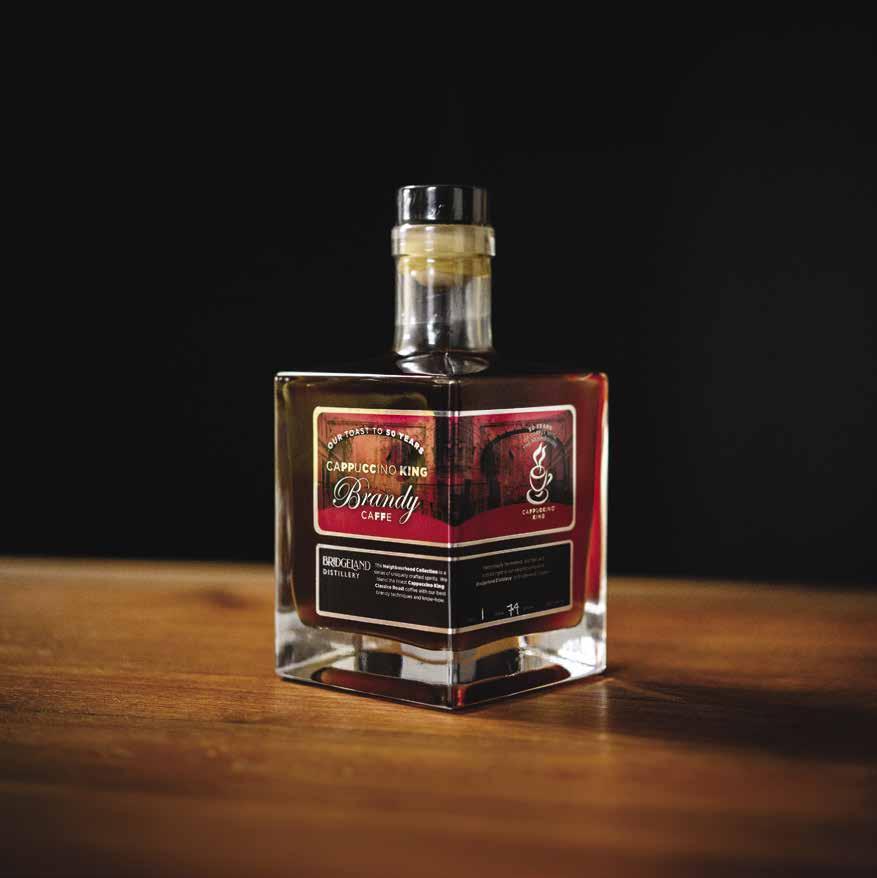
50 Y EARS OF COFFE E & FAMILY
Our neighbour, Daniel Plenzik at Bridgeland Distillery, saw a spirited way to help us toast our year by doing what he does best – craft for us a unique blend of my father Vince’s Italian Roast coffee with his award-winner brandy. Pick up a bottle of this limited-edition co-creation at the Distillery in Bridgeland (77 Edmonton Trail NE.) Then enjoy this festive coffee with your own neighbours, something that would bring joy to my dad. – PETER IZZO
INSPIRED BY THIS, OUR FRIENDS AT MONIN GOURMET FLAVORINGS CREATED FOUR ANNIVERSARY THEMED COCKTAILS THAT FEATURE BRANDY CAFFE –JUST FOR US.
SCAN THIS CODE to download those recipes and get on our list to receive other refreshing recipes as well.
WE SUPPLY IN-THE-KNOW CALGARIANS WITH LOCALLY ROASTED TRUE ITALIAN-STYLE COFFEE AND PRETTY MUCH EVERYTHING ELSE THAT GOES ALONG WITH IT.
WE CARRY AND SERVICE: LET US SUPPLY YOU WITH:






403.277.5169 410 23 AVENUE NE, CALGARY CAPPUCCINO KING .COM
Chicken Sandwich Dilemma
Chicken sandwiches have it all: messy, fun, flavour-packed and open to any combination of ingredients that tickles your fancy. Pile on the toppings, change up the buns, add all the flavourschicken can handle it. The only question is, “can I eat them all?”
STORY AND PHOTOGRAPHS BY
NATALIE FINDLAY
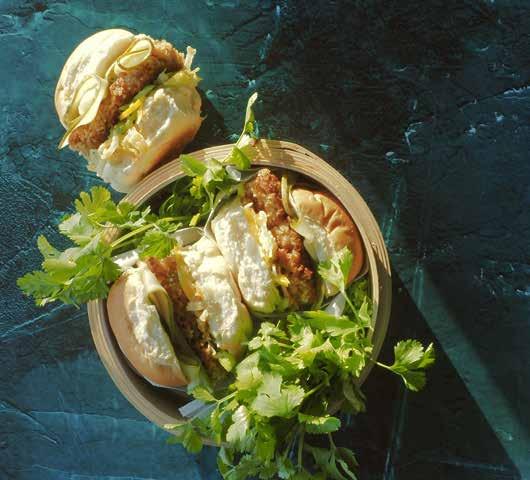
Panko Crusted Chicken
Slider with Pickled Cucumber and Kimchi Mayo
Makes 4 sliders
Mayo
2 Tbs (30 mL) mayo
3 tsp kimchi, pureed
Whisk together in a small bowl.
Pickled Cucumber
1 cup (250 mL) rice vinegar
1 tsp (5 mL) mirin
1 tsp sugar
½ English cucumber
6 black peppercorns
2 anise seeds
1. In a small pot over medium high heat bring vinegar, mirin, and sugar to a boil.
2. Meanwhile, thinly slice cucumber into strips (using a mandolin or knife).
3. Place the cucumber into a glass jar. Add the boiled vinegar mixture, peppercorns, and anise seeds.
4. Let sit at least 30 minutes before using. Lasts one week in the fridge.
Slaw
1 cabbage, large leaf
1 stalk celery
¼ yellow bell pepper
6 snap peas
2 Tbs sesame seeds
2 Tbs (30 mL) rice vinegar
½ tsp (3 mL) mirin
2 Tbs (30 mL) sesame oil
Pinch sea salt
¼ tsp sugar
1. Add the cabbage, celery, pepper, peas, and sesame seeds to a large bowl.
2. In a small bowl whisk together the rice vinegar, mirin, oil, salt, and sugar. Drizzle over the cabbage mixture and toss to coat.
Panko Crusted Chicken
⅓ cup (80 mL) soy sauce
1 Tbs (15 mL) rice vinegar
1 clove garlic, grated
4 boneless chicken thighs (can use breasts)
1 cup panko
4 Tbs rice flour
1 egg + 1 Tbs (15 mL) marinade
2 Tbs (30 mL) avocado oil
4 buns
1. In a medium bowl, whisk together the soy sauce, vinegar, and garlic. Add the chicken to the bowl and turn to coat. Refrigerate 30 minutes to 8 hours.
2. In 3 separate shallow bowls, place panko, flour and egg (one in each bowl).
3. One at a time, remove a chicken thigh out of the marinade, let excess marinade drip back in, then dip in flour to coat all over.
4. Whisk egg and 1 Tbs (15 mL) marinade together. Shake off excess flour then dip chicken in the egg mixture to coat. Shake off excess egg mixture, then dip both sides in panko and let rest on a cooling rack. Repeat with remaining cutlets.
5. In a 25 cm skillet, heat about 6 mm of oil over medium heat.
6. Line a plate with paper towels.
7. Once oil is hot (a piece of panko dropped into the pan should sizzle immediately), fry two cutlets at a time until golden-brown underneath, 2 to 3 minutes. Turn cutlets over and continue frying until golden-brown. Transfer back to the cooling rack so the panko doesn’t get soggy. Repeat with the remaining chicken thighs.
8. Spread the kimchi mayo on the bottom and top buns, add the slaw, top with the chicken, add the pickled cucumber and the top bun.
18 Culinaire | June 2024
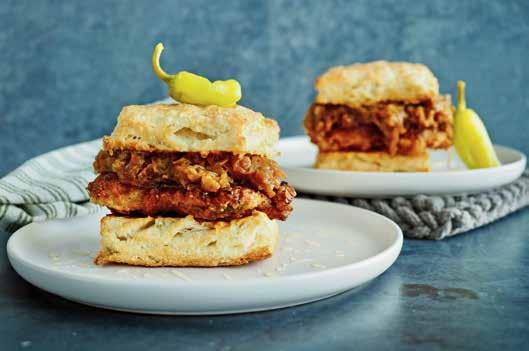
Fried Chicken Sandwich on a Buttermilk Biscuit
Makes 4
Butter
2 Tbs butter, softened
1 Tbs (15 mL) honey
1 tsp (5 mL) chili garlic sauce
Mix all ingredients together in a small bowl.
Caramelized onions
2 Tbs butter
4 small onions, sliced thin
1 tsp salt
1. In a small pot over medium high heat add butter and melt.
2. Add onions to pot. Stir to break up onions.
3. Add salt, stir. Cover and cook 30 minutes, stirring every 5 minutes.
Marinade
4 chicken thighs
½ cup (125 mL) buttermilk
1 tsp sea salt
4 cloves garlic
Seasoning Mix
1 cup flour
1 cup cornstarch
2 tsp kosher salt
1 tsp black pepper
1 tsp ground thyme
1 tsp ground oregano
½ Tbs garlic powder
½ Tbs onion powder
½ Tbs paprika
1 tsp cayenne powder
1 Tbs baking powder

Seasoning
Mix
½ cup seasoning mix
½ cup (125 mL) water, cold Oil for frying
4 buttermilk biscuits
1. In a medium glass bowl add chicken, buttermilk, salt, and garlic. Marinate 2-4 hours or overnight.
2. In a large mixing bowl, combine all dry seasoning mix ingredients and whisk until combined.
3. Take ½ cup of your seasoning mix and combine in a separate bowl with cold water and mix until smooth.
4. Remove the chicken from the marinade and pat dry. Spoon a few tablespoons of the marinade into the seasoning mix and rub together with your hands to create small clumps. These craggily bits will add extra texture to the chicken.
5. Dip each piece of chicken in the wet batter and let any excess drip off. Immediately dredge in seasoning mix and press the mix into the chicken until completely coated. Let rest on a cooling rack while you heat up your oil.
6. In a large cast iron pan, Dutch oven, or heavy bottomed pan/wok, fry chicken at 350º F for 8-12 minutes (depending on size of the chicken) or until the internal temperature reads 165º F. Remove and briefly rest on a paper towel lined plate.
7. Spread the spicy honey butter on your warm biscuits, add the fried chicken and top with caramelized onions and then the top of the biscuit.
Shredded
Orange Chicken on a Brioche Bun Serves 4
4 chicken thighs
2 chicken breasts
1 cup (250 mL) chicken stock
1 cup (250 mL) water
1 orange, juice and zest
1 small onion
3 cloves garlic
1 medium carrot
1 tsp salt
4 brioche buns
4 Tbs (60 mL) mayo
4 leaves lettuce
¼ red onion, thinly sliced
1 avocado, sliced
1. Add the first 9 ingredients to a medium pot. Bring to a boil, reduce heat to a simmer and let cook about 25 minutes or until chicken is completely cooked.
2. Remove chicken from the pot and remove bones and skin (if necessary) and shred chicken.
3. Puree the liquid in the pot and increase heat to medium high and reduce to half, approximately 15 minutes.
4. Add shredded chicken back to pot and coat with sauce.
5. Toast buns.
6. Slather with mayo. Layer on the lettuce, a big scoop of shredded chicken, thinly sliced red onion, avocado, and the top bun.
Natalie is a freelance writer, photographer, and pastry chef. A graduate of Cordon Bleu’s pastry program, she manages her own business too to create custom-made cakes.
June 2024 | Culinaire 19
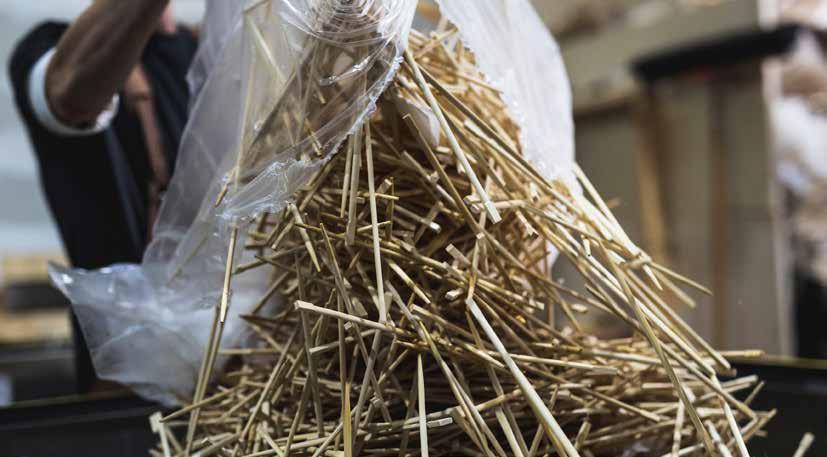
From waste to resource, one chopstick at a time
Do you ever think about what happens to the chopsticks you use at the restaurant, or fast-food spot? Most of us don’t give it a thought, and neither did Calgary’s Joanne Dafoe–though she’s now on a mission to change that.
The Calgary-raised, former owner of a landscape design business says she’s always been a bit of an entrepreneur and ‘pie-in-the-sky’ dreamer, but it was while at home during the pandemic, when a different idea occurred to her.
“I loved design work but I remember saying I felt something else was out there for me,” recalls Dafoe. “Three days later I was introduced to ChopValue. Before I knew it, I was meeting founder Felix Bock at his microfactory and head office in Vancouver, and he asked if I wanted to be the first franchisee for the company. There’s that saying about putting things out into the universe – I felt it was happening right then for me.”
Dafoe remembers being impressed with
Bock (a woodworking engineer with a PhD in bamboo) and his goal of creating high quality, wood alternative products that save on carbon emissions at the local level and, cumulatively, on a global scale. Dafoe was quickly sold on the idea, and now, less than four years after signing on in December, 2020, the Calgary team (Dafoe, partner and son Mike Bodnar, his wife Kim and a total of seven employees), and 10 other global franchises are making sustainable manufacturing a reality, one chopstick at a time.
This is how it works: once a week, the ChopValue YYC driver picks up used bamboo and wood chopsticks from local businesses – at no charge – and, once they’re cleaned at the microfactory, turns them into minimalistic new products; everything from table tops and feature walls to cabinets, office desks, chopping boards, wall shelves, and even domino sets.
“It’s about closing the loop, creating a circular economy that takes something from waste to resource. And by doing
it all on a local level, we’re creating jobs right here, eliminating shipping issues and providing all the customer service/ support a customer needs. The ‘made local’ approach is hugely important to us, and becoming more and more important to businesses and the public,” Dafoe says.
It’s those very things – the benefit of dealing with a local, family-run business,

20 Culinaire | June 2024
BY LUCY HAINES PHOTOS COURTESY CHOPVALUE
Chopsticks to shaker table
and having a passion for doing things right on the ‘green’ front that led Calgary restaurant owner Sarah Luong to be the first to sign on with ChopValue YYC a few years back. At her popular Vietnamese restaurants Pho Dau Bo and later Mot To, Luong says it’s been a no-brainer to get the roughly 1,000 pairs of used chopsticks picked up weekly By ChopValue YYC, saving on disposal costs for her and doing something positive in the process.
“It’s a win-win. I reached out after I read about ChopValue on social media, and I visited the factory and saw how hands-on Joanne’s family was. We’re a family-run business too, so I wanted to support that,” Luong says. “But it’s also meaningful for our business to be part of this awesome program and let customers know about it when they see our furniture made from the chopsticks–table-tops and a bar panel. They’re unique and beautiful – real conversation pieces, and it keeps the idea of green living top of mind.”
Dafoe points to tabletops, floating shelves and coffee bars created for McDonald’s restaurants in Calgary, and communal tables for Little Kitchen Academy cooking school in Edmonton as examples of collaborating with corporations with aligned values; those which are choosing sustainable options for their businesses.
ChopValue YYC employs one driver and four furniture makers who create customordered pieces in a 4,000 square foot shop and showroom. And beyond pursuing partners in business (Kim’s special focus), Dafoe and family reach the public at local farmers’ markets and home and garden shows.
“We’re lucky to have manufacturing students from SAIT, including a red seal certified cabinet maker, help us create these unique, premium quality pieces. The growth is inspiring. People are asking about our products now,” Dafoe says, acknowledging that while custom-made bamboo furnishings can be more expensive, consumers are far more savvy today, understanding the benefits of buying local and reducing their carbon footprint.
To date, ChopValue YYC has acquired some 210 collection partners in the Calgary area (including Chinook Centre shopping mall), and 24 spots in Edmonton. As Alberta’s lone franchise (there are two in the Toronto area, and several across the globe – the US, Mexico, Bali, and

Singapore), ChopValue YYC collects about 1,000 kg per month; that’s three million chopsticks – 75 per cent of which are bamboo.
“We know we’re making an impact –feeling the tractions. We started from ground zero but after three years of pounding the pavement, learning to be relentless and circling back with people, (even Calgary City Council and the federal government), people now say, ‘we’ve heard of you’. It’s what I had hoped for.”
Dafoe says starting a new business in her 50s initially caused her pause, but she saw the potential for growth (ChopValue YYC just celebrated its best quarter to date). And though starting a business is a 24/7 venture, Dafoe says doing work that is meaningful makes all the difference.
“I have two young grandkids, so my goal is to leave a legacy for them,” the now 53-year-old Dafoe says, adding it’s also about doing the best for her son, who put himself through university, ran his own sod installation business and became a geologist before adding duties with ChopValue alongside his mom.
“I’m so passionate about this – it checks all my boxes,” Dafoe says. I never used to
think that doing this with my family was important, but it is.” Dafoe’s daughter and her husband, who both work full time, also pitch in when needed, often helping put orders together and sort chopsticks on weekends.
“My daughter says, ‘Some moms and daughters go for brunch, but my mom and I sort chopsticks,” Dafoe laughs. But we talk non-stop – we get to visit, and the time goes by. It’s a totally unexpected thing. Who would’ve thought?”
“If I can run a green business and prosper, if I can show I’m thriving within a green community, it can motivate others to do the same. Has it been easy? Hell no. But people’s livelihoods depend on me, so I want to keep telling my story. And we’re just coming to a place where I can take a weekend off. Having people come to us about the program and the furniture; we can feel the traction now, and it’s inspiring.”
Lucy Haines is a long-time freelance writer, specializing in travel, food, arts and entertainment. When she isn't writing, Lucy is a busy mom to four fantastic kids, and enjoys singing and performing in the local community theatre scene.
June 2024 | Culinaire 21
Dritan and Albana Qose, with sons Ani and Alex
The Dafoe Family

Detroit Style Pizza Deep Delicious &
STEP BY STEP
STORY AND PHOTOGRAPHS BY RENÉE KOHLMAN
Pizza, in all its shapes and sizes, sauces and toppings, is one of the most delicious things to eat. Even bad pizza isn’t so bad! There are thin and crispy crusts, thick and chewy crusts, and then there is Detroit-style pizza. If you’re not familiar with this style of pizza, don’t worry - you don’t have to hop on a plane to the Motor City to give it a try. With a few tips and tricks you can make this super delicious pizza in your own kitchen.
What sets Detroit-style pizza apart from other pizza? First off is the pan it’s baked in is typically a 25x35 cm (10x14 inch) rectangular pan with high sides, which ensures a deep dish pizza pie. And, to ensure a tender-yet-chewy crust, a high hydration dough is made with bread flour instead of good old all-purpose flour. Then there is the way the pizza is assembled. Pepperoni is the typical topping and half of it is placed directly on the dough, then cheese, then pepperoni. When applying the cheese, it’s important to push it all the way to the edge of the dough so it melts into the edges of the pizza forming a crisp, golden brown crust. And finally, the sauce goes on last. It’s a bit of a switcheroo, but with one taste, you can see how it works. This pizza is thick and chewy, crispy and cheesy, with a rich, tangy sauce. It’s a stunning example of simple ingredients doing extraordinary things, and while you may not want to eat it every day, or every month for that matter, it’s important to eat it at least once.
Rather than purchase a pan specifically for this style of pizza, I used a large cast iron skillet that I already had. If you would like to go the rectangular route, then I suspect a standard 23x33 cm (9x13 inch) pan would suffice. And, while I included my recipe for a pizza sauce, you could take a short cut and purchase your favourite, or make your own.
I would recommend using the bread flour though - don’t use all-purpose, and I stayed the traditional route with pepperoni. If you want to keep it vegetarian, you could add mushrooms, but I would sauté them first as they would release too much liquid onto the pizza and make it soggy. And I think we all agree that soggy pizza is not what we’re after. You’ll want to cook the pizza in a very, very hot oven, as hot as it will go, ideally 500º F. It won’t take long until you have a golden, gorgeous, pan of pizza to call your own. Waiting a few minutes to slice it is the
hardest part, and that first bite… oh, it’s a good one!
Detroit-Style Pan Pizza
Serves 4
Crust
2 cups plus 2 Tbs (300 g) bread flour
1½ tsp salt
1 tsp instant yeast
1 cup (250 mL) water
Olive oil, as needed
Toppings
340 g Mozzarella, Monterey Jack or Fontina cheese, cubed
300 g sliced pepperoni
Sauce
2 Tbs (30 mL) olive oil
1 yellow onion, diced
2 garlic cloves, minced
1 tsp Italian seasoning
1 tsp dried oregano
1 tsp dried basil
1 tsp salt
½ tsp pepper
Pinch red pepper flakes
2 Tbs (30 mL) tomato paste
1 796 mL can crushed tomatoes
1 Tbs granulated sugar
1 tsp granulated garlic powder
1 tsp granulated onion powder
2 Tbs butter
1. To make the crust: in the bowl of a stand mixer fitted with a dough hook, stir together the flour, salt, and yeast. Add the water, and mix on the lowest speed until the dough comes together into a rough ball, about 10 minutes. Let it rest for 10 minutes, then mix on medium-high speed until the dough turns into a silky soft ball, another 10 minutes. It will likely stick on the bottom of the bowl as it kneads. Remove the dough from the bowl, and on a lightly floured surface, knead the dough into a tight ball and place it into a lightly greased bowl. You can just grease the same mixing bowl you used for the dough. Cover the bowl with plastic wrap and set aside at room temperature until the dough has doubled in size, about 2 hours.
2. Meanwhile, make the sauce: heat a Dutch oven over medium-high heat and add the oil. Add the onions, and cook until they soften, about 5 minutes. Add the garlic, and cook for another minute until fragrant. Add the dried herbs, salt, and
pepper. Stir to combine, then add the red pepper flakes and tomato paste. Stir to evenly coat the onions. Add the crushed tomatoes, sugar, garlic powder, and onion powder. I like to rinse out the can of tomatoes with about ½ cup (125 mL) water and add this to the sauce as well. Turn the heat to medium-low, and simmer, partially uncovered, for about 45 minutes, stirring occasionally. Stir in the butter and season to taste. Let the sauce cool completely before assembling the pizza.
3. Pour about 2 Tbs (30 mL) of olive oil into a 30 cm (12") cast iron skillet, or heavy metal pan. Transfer the dough to the skillet and turn to evenly coat. Press the dough into the edges of the pan, dimpling it with your fingertips as you go. If it starts to shrink back, just cover the skillet with plastic wrap and let it rest for another 15 minutes, then repeat the dimpling and pressing. Stretch the dough beyond the pan so it will relax down into the pan. Cover with a damp towel and let it rest for 30 minutes.
4. Set one oven rack to the lowest position and another about 15 cm from the top. Preheat the oven to 500º F.
5. Evenly scatter half of the pepperoni over the dough, then top with the cheese, spreading it evenly and all the way to the very edges of the pan, then add the remaining pepperoni. In three concentric circles, spoon the sauce evenly over the surface. You will likely need just half of the sauce, so save the rest for dipping the pizza or for future pizza prep.
6. Bake the pizza on the lowest rack until the edges of the crust are a rich, golden brown (you can use a metal spatula to lift up the edges and check), about 15-20 minutes. If the cheese is bubbling but the crust isn’t browned, cook for another 2-4 minutes. However, if the bottom is brown but the top isn’t, you can move the pizza to the top rack and cook for another 2-4 minutes. Once you’re pleased with all the browning, remove the pizza to a cooling rack. Let it rest a few minutes, then run a metal spatula around the edge of the skillet to loosen. Carefully lift it out and slide it onto a cutting board. Do not leave the pizza too long in the skillet otherwise it will go soggy. Slice the pizza and serve immediately.
June 2024 | Culinaire 23
Renée Kohlman is a busy food writer and recipe developer living in Saskatoon, Saskatchewan. Her second cookbook, ‘Vegetables: A Love Story” has just been published.
The Big Dusty Book of… Old Styles, New Tricks: Belgian beer and its dynamic culture
STORY AND PHOTOS BY KEANE STRAUB

In the last few years, Belgium has inspired craft brewers in Alberta to try their hand at creating several Belgian styles. Session beers, sours, tripels, and more, are popping up in local taprooms, but there’s a trade-off: those who enjoy these Belgian styles here in Alberta may not be aware of the scale and importance of Belgium’s beer culture.
Home to over 400 breweries, and with brewing traditions that stretch back to the 15th century, this postage stamp-sized country is swiftly becoming a hotbed for beer tourism. Belgium is not only a place where modern beer started, but also a good indication of where it is headed.
In 2016 UNESCO inscribed Belgium Beer Culture as a representative of Intangible Cultural Heritage of Humanity, citing the country’s efforts to preserve and promote this expansive culture not only within its borders, but on a global scale, too.
A large part of this effort is housed in the old Brussels stock exchange building. Belgian Beer World is a collective work partially funded by major Belgian breweries. Here, several galleries focus on the history, art, science, and commerce of brewing, with an emphasis on being entertaining and educational, and accessible to visitors from almost any demographic. The upper levels offer a chance to discover
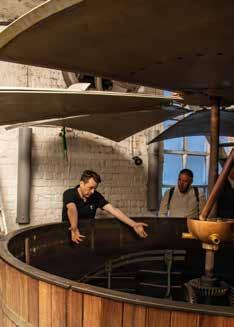
Belgian beers based on your tastes via an interactive quiz, and a final stop to enjoy a tasting in the Skybar overlooking the city. A central hub for Belgian beer culture, even the most pressed for time will have a chance to explore all it has to offer.
Breweries both big and small are making efforts in their own establishments to share their culture. Among beer connoisseurs, Cantillon Brewery has a reputation that has outgrown its brewery walls, and far exceeds the amount of beer produced in a season. The last lambic brewery in Brussels, its methods have remained the same since it was founded in 1900. Currently run by fourth-generation brewer Jean-Pierre van Roy, the fifth generation is already in place to take over. As Cantillon representative Senna Rees puts it, “It’s nice to see Cantillon’s story will not be finished in the foreseeable future.”
Declining sales of lambic in the 60s and 70s threatened Cantillon’s closure, so a living museum was established in 1978. Today, guided tours feature historical equipment still in operation, from the mash tuns and red copper kettles, to the koelschip, the traditional vessel where wort is cooled during lambic production. “The reason the brewery still exists is the museum, and the museum is where we tell our side of the story about how we do things and how we see things,” says Rees.
24 Culinaire | June 2024
Former Brussels Stock Exchange La Bourse, home of Belgium Beer World
Cantillon Representative Senna Rees explains the intricacies of the mash tun which has been used since 1900.
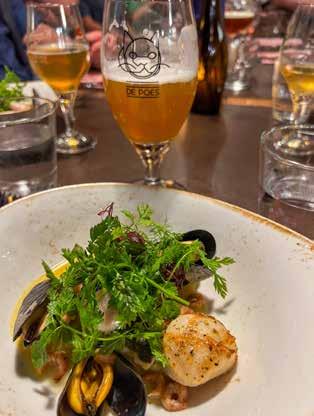
“We’re not just about lambic. This is industrial heritage.”
Other historical breweries in Belgium have recognized a need to expand their stories and take advantage of a flourishing beer tourism industry. The Omer Vander Ghinste Brewery in Kortijk, established in 1892, became more accessible to the public in 2020 with the addition of a visitor’s centre and taprooms. And at St. Bernardus Brewery in Watou, a newly opened experience centre takes visitors on a selfguided tour from Trappist relations in the 19th century to the more recent establishment of Kazematten Brewery, the first brewery in Ypres since the 70s.
Gastronomy is also playing a large part in Belgian beer culture. With beer in tow, chefs are venturing into territory once reserved for wine. Dishes created with beer in both commercial and home kitchens range from sea bass and shrimp gravy made with Watou Whitbier and Penne Al Forno with Omer Traditional Blond, to ice cream made with St Bernadus Abt 12. Taprooms and restaurants are creating pairing menus too, allowing guests to sample from several different breweries while also enjoying a vast range of cuisine.
Food pairing was Hans Dusselier’s motivation for establishing Heilig Hart Brouwerij in Wetteren. Twenty years ago, he began importing natural wine to Belgium and ten years later he added sake to the list, both of which he knew were natural fits with the country’s expansive culinary offerings. Dusselier then took on the challenge of bringing beer and food closer together. “It’s difficult to pair Belgian beer with dishes because we’re the land of the tripels,” he explains. “There are great traditional beers made by bigger brewers which are already available. I wanted to make beers that could pair with food for chefs to use.”



continues on page 26
Sea bass fried in farm butter, stewed leek, shrimp gravy with Watou's wheat beer, North Sea shrimp

Hans
Dusselier,
owner
and
brewer
of Heilig Hart, talks about his journey to finding the brewery, and his brewing processes
After studying brewing, he set out to find a suitable home where he could brew beers that are unlike anything available in Belgium. With a bit of luck, and support from a Catholic bishop in Ghent, he came across a Catholic church for sale. With the nearby Scheldt River, the area is a perfect ecosystem for natural brewing and spontaneous fermentation. But Dusselier was cautioned by a friend about the dangers of brewing such a unique style of beer. “My friend said, ‘Hans, you’re not brewing gueuze or lambic. You’re trying something completely different. It will be way too difficult if you only play to a niche market.’” “So, I added a tripel,” he laughs.
It’s part of a three-tiered offering at Heilig Hart: ‘The Father,’ which is made up of traditional Belgian styles; ‘The Son,’ experimental beers with different brewing methods and ingredients resulting in unique tastes; and ‘The Holy Spirit,’ which are spontaneous fermented beers. The last two tiers are where Dusselier, and his son Victor, get creative with ingredients like Greek yogurt, orange peel, and sea buckthorn. Fermentation and lagering may take place in wood barrels, clay amphora, or a combination. It’s not an exact science, but instead a continuous flow of trial and error. “Completely different methods of brewing produce different tastes,” says Dusselier, “and experimenting is important for us, as brewers, to discover why certain things happen in the process.”
In Ghent, DÖK Brewing is on a mission to blend old and new. A joint venture between three existing breweries, DÖK was established to tackle one widespread problem: lack of interest beyond traditional beers. “The reality is we have a beautiful old beer history, but Belgians themselves, sadly, don’t celebrate it that much,” says DÖK representative Jasper Pollet. It’s understandable – people have their go-to styles, and in Belgium those tend to be dubbels and tripels. DÖK tries to make all styles accessible to their

guests and features 30 rotating taps with DÖK’s own creations, a selection of local styles and some from all over the world, including Brazil, Lithuania, and even Alberta.
The brewery puts emphasis on reintroducing the Belgian styles with their own twist, while making available the international styles they are influenced by. “Customers come in and think they’re going to have a nice, locally brewed dubbel. Well, we have something like a dubbel. We want to encourage people to try something new. At the end of the day, you want to get the right beer for the right person,” adds Pollet. “We want to make sure if you’re spending money on our beer, it’s something that you like.”
Relatively speaking, Alberta is a youngster when it comes to brewing, so perhaps we worry less about tradition and focus more on innovation. That isn’t to say we don’t have anything in common with Belgium and its brew. It comes down to a few universal goals shared among brewers: to make good beer, to educate people, and to share their passion.
A quick guide to some Belgian beer styles mentioned here:
Lambic (4-8% ABV) spontaneously fermented through exposure to wild yeasts and bacteria as opposed to exposure to brewer's yeast. This is what produces its distinct flavour: dry, vinous, and cidery, often with a tart aftertaste.
Gueuze made by combining ‘young’ lambic (1 year old) and ‘old’ (2-3 years), which is then bottled for a second fermentation.
Dubbel strong brown ale (6-8% ABV) with understated bitterness, a heavier body, and pronounced fruitiness.
Tripel strong pale ale (9% ABV or more) that is notably spicy and dry with a firm bitterness and a well-rounded malt flavour.
26 Culinaire | June 2024
DÖK Brewing from behind the 30 taps looking into the large warehouse taproom.
PASO ROBLES DEFINED
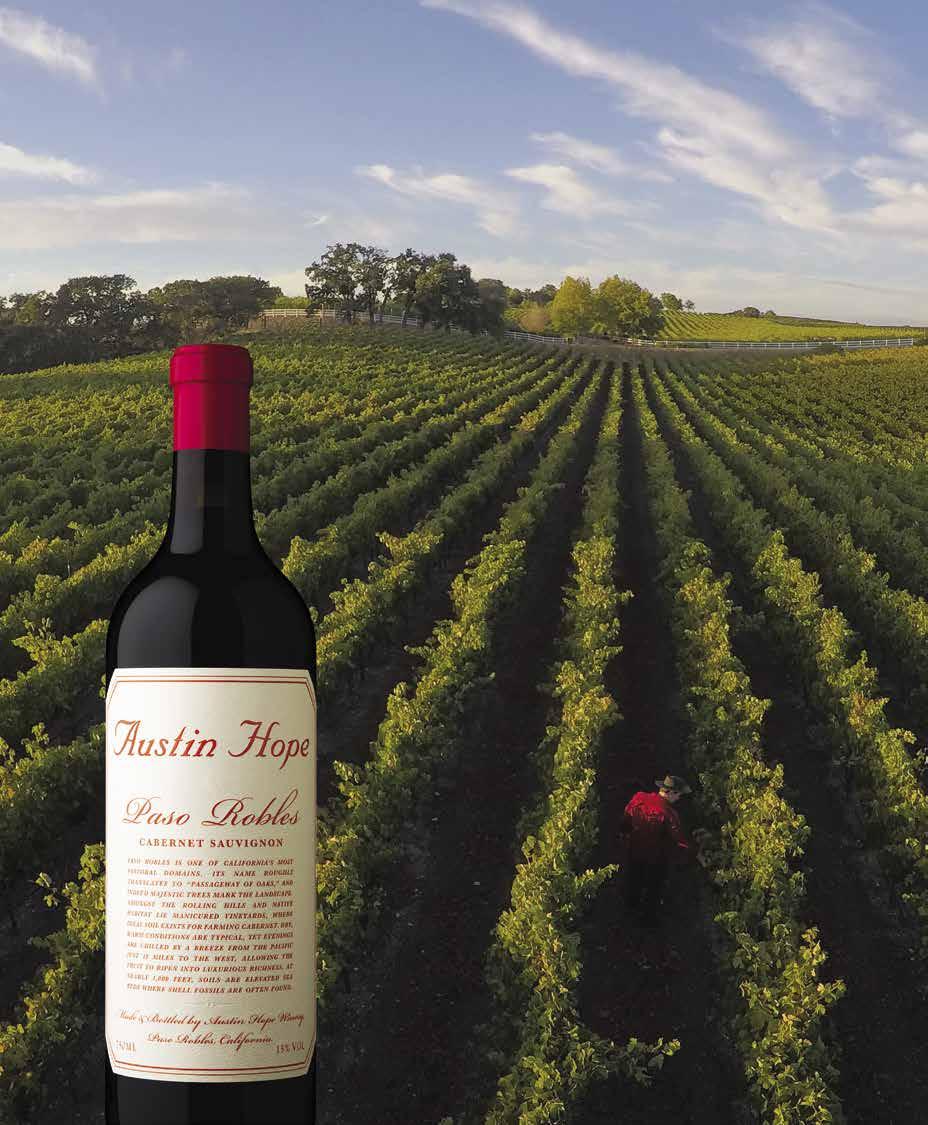
PASO ROBLES
PRODUCT OF THE USA
The BUZZ about Bourbon
America’s “Official” Spirit is only 60 years old, but its history goes back to the 18th century
Bourbon County, in Kentucky, was established nearly 240 years ago, in 1785, at a time when settlers were looking for alternative ways of marketing their corn and other grain crops. They realised that distilling it prevented it from spoiling, and putting it in barrels made it easy to transport, so Bourbon County became a hub for the whiskey trade, with the Ohio and Mississippi rivers used to transport the barrels, stamped “Bourbon County”, to New Orleans. If you’ve visited New Orleans, you’ll likely have walked down the 12 blocks of Bourbon Street in the French Quarter, famous for all its bars.
The long journey aged the whiskey, with the oak wood from the barrels lending a mellow flavour and amber colour, and as it became more and more popular, it became known as simply ‘Bourbon’. 95 percent of the world’s Bourbon is produced in Kentucky, so we recently made a visit to Louisville to find out more of the history, learn how Bourbon is made (and sample it too), and what this means for us here in Canada.
Apart from KFC; the famous sons of Abraham Lincoln, Muhammad Ali, George Clooney, Tom Cruise, and Johnny Depp; the Derby (150th last month!); and the Corvette, disco ball, and baseball bat factories (I’m reminded here of the Monty Python sketch “What else did the Romans do for Britain?”); we discovered that George Garvin Brown created Old Forester, the first bourbon to be sold in sealed glass bottles instead of barrels, in 1870 on Louisville’s Whiskey Row, also home to the Frazier History Museum, the starting point of the Kentucky Bourbon Trail, which is celebrating its 25th anniversary this year.
And we learnt that with a population

very similar to Alberta, there are currently more than two and a half barrels of bourbon aging in Kentucky for every resident. So what’s the big deal with Bourbon?
In 1964, Congress officially declared Bourbon an indigenous product of the United States, meaning all bourbons are whiskies but not all whiskies are bourbons - no other country can make a spirit and call it Bourbon – this whiskey can only be made in the United States. Having said that, bourbon can be made anywhere in the US, as long as it is made to the very strict rules, some of which date back to the early 1900s.
To be called Bourbon, the whiskey must:
• Be made with a minimum of 51 percent corn. The remainder of the mash bill is malted barley, rye, or wheat.
• Be aged in new, charred oak containers. Note that the law doesn’t mention ‘barrel’, just charred oak containers!
• Be distilled to 160 proof (80 percent ABV) or less. A higher proof spirit would lose much of the flavour of the grains, and at 160 percent proof there are small amounts of congeners in the spirit that add to the flavour of bourbon. Congeners are produced naturally and are by-products of the fermentation and
28 Culinaire | June 2024
STORY AND PHOTOGRAPHS BY LINDA GARSON

distillation process. Examples would be esters, tannins, and aldehydes.
• Be stored at no more than 125 proof (62.5 percent ABV). The higher the proof of the bourbon, the more quickly it will pull flavours from the oak, so this rule is to prevent too much extraction from the wood so that it doesn’t taste too ‘oaky’.
• Be bottled at no less than 80 proof (40 percent ABV). This is a rule for all whiskies.
• Contain no flavouring or colouring agents. Only water can be added to the spirit when it is removed from the barrel.
There are two more rules:
• ‘Straight Bourbon’ is aged for at least two years in charred oak containers. Straight bourbons aged between two and four years must have an age statement on the label declaring the age of the youngest spirit.
• ‘Bottled in Bond Bourbon’ is aged a minimum of four years, and has to be distilled in a single season, and bottled at
LIMONCELLO

100 proof (50 percent ABV).
These rules guarantee a consistent spirit and make the bourbon we know (and love!) today. Of course there are variances in flavour - bourbons with a higher amount of wheat are generally softer and sweeter, more rye could make the whiskey spicier etc, and the source of the water can make a difference too.
The location can make a big difference too: Kentucky Bourbon must be distilled and barrel-aged in the state for at least
two years, so we expect to find flavours of vanilla and caramel, whereas Texas is much hotter, and the evaporation rate is twice that of Kentucky bourbon, which can affect the alcohol content and gives a more fruity taste.
We’ve thought and talked a lot about this fascinating spirit, so it’s time for us to let you have some of our picks, and on the following two pages we’ve included twelve bourbons that we have personally tried and can stand behind.
liquorconnect.com shows 520 bourbons registered in our province (some may be different size formats of a brand) from distilleries in almost half the US statesand just under 300 from Kentucky alone. They may not all be available today, but using the CSPC code, you can check with their importers when they’ll arrive if they’re out of stock, or where there might be a bottle or two on the shelf if they’re hard to find.
As liquor stores in Alberta can set their own prices, all prices are approximate.
If you’re a fan of bourbon and thinking of visiting Kentucky, there are some festivals you might want to check out:
‘Bourbon & Beyond’ is declared the World’s Largest Music, Food, & Bourbon Festival and this year takes place September 19-22. There’s a huge line up of artists, including Neil Young! bourbonandbeyond.com ‘Bourbon & Belonging’ is the first LGBTQ+ inclusive bourbon festival in the United States. This year, it takes place October 2-6, across eight different cities and counties in Kentucky. bourbonandbelonging.com



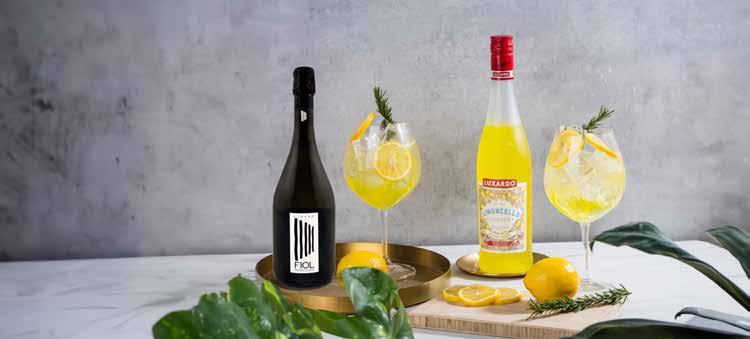
Please enjoy responsibly.
2 oz. Luxardo Limoncello 3 oz FIOL Prosecco Top with soda Method: Build Garnish: Lemon Wheel And Enjoy!
SPRITZ
Bourbon for Savouring,

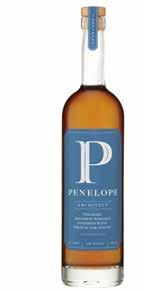


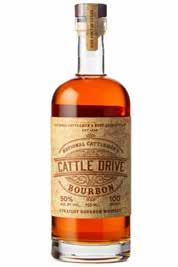
 WBY TOM FIRTH AND LINDA GARSON
WBY TOM FIRTH AND LINDA GARSON
e’ve been really excited about sharing some bourbons for this month – from Kentucky, Texas, Indiana, and California. Might be that Father’s Day is close at hand, but maybe we’ve been more excited about the prospect of those warm summer evenings in Alberta with a good friend or two – maybe a father or father in law – enjoying a good drink until the wee hours. A drink to savour, swirl, and sip, but also something to enjoy when the conversation finds a quiet moment – that moment that just feels right.
Brother’s Bond Straight Bourbon, Indiana, United States
Refreshingly bottled at 40 percent ABV and made from a mash of four grains, corn, rye, wheat, and barley, this is finely crafted and well balanced too with mild caramel tones, good fruit and citrus notes, and a mild, maple like finish – which works oh-so-well with those baking spice aromas. Very mellow with excellent mouthfeel, it’s a beautiful, smooth sipper. Our recommendation? Maybe a single cube of ice and you are ready to enjoy.
CSPC 873258 $85-95
Penelope Toasted Series Straight Bourbon Whiskey, Indiana, United States
Penelope found out early on how toasted barrel finishes can vary so much that you can’t predict the flavour profile, and decided to embrace this with their Toasted Series, and finish the bourbons in a new freshly toasted barrel – char level 5 and heavy toast in this case. Plenty of vanilla from the barrel, and less sweet, this is for those who love those smoky tones - like us!
CSPC 889793 $150-155
Penelope The Architect #6 Bourbon, Indiana, United States
Bold and spicy, The Architect #6 is made from 75 percent corn, 21 percent rye and a touch of malted barley, and where it differs from Penelope’s other offerings is the use of French oak staves for finishing – two types, Delicate and Intense for low and medium tannin. It starts with creamy custard/crème brulée aromas, and on the palate moves to more dark chocolate and coffee that open up with a drop or two of water.
CSPC 889790 $120-124
Rebecca Creek Texas Straight Bourbon Bottled in Bond, Texas, United States
Maybe it’s that things are bigger in Texas, or maybe it’s the significant rye content in this bourbon (bottled at 50 percent ABV) but this all comes together in a bold, fiery spirit. Spice and leather with caramel on the nose, but good subtlety on the palate too with soft, almost peachy fruits under those rye and corn notes. Big, but best – neat.
CSPC 891083 $105-115
Copper Tear Cattle Drive 100 Proof Bourbon, Texas, United States
Lean, leathery, and luscious too. This is a very spicy approach to bourbon with a solid underpinning of oak characteristics and some stronger corn mash notes. It would be a disservice to call it a shooting bourbon, but to get the best from the apple fruit and sugary/maple notes, a splash of water to cut the heat or a simple cocktail would be best.
CSPC 891347 $96-100
Wheel Horse Kentucky Straight Bourbon, Kentucky, United States
A blend of corn, rye, and barley in the mash comes together very well indeed here yielding an overall aroma bringing out the best of each. It’s on the palate though that Wheel Horse really shines with silky textures very well integrated barrel characters, and a long, graceful end. Bottled with a kick, it absolutely is best neat. Put this one in your wheelhouse.
CSPC 869120 $65-70
30 Culinaire | June 2024
Swirling, and Sipping
Kentucky Owl The Wiseman Kentucky Straight Bourbon Kentucky, United States
Big and even robust, but still showing remarkable smoothness to soften those hightoned alcohol characters, but best of all is the caramel and spicy finish tying it all together in a mildly sweet approach. Bottled around 45 percent ABV, but very easy to enjoy neat or in a good cocktail. This was the "Best in Class" Bourbon at the 2023 Alberta Beverage Awards.
CSPC 866269 $73-78
Angel’s Envy Kentucky Straight Bourbon Whiskey Kentucky, United States
Angel’s Envy (they only get about 5 percent from evaporation, that’s why they’re envious) has a very traditional mash bill with nearly three-quarters corn, but the big difference is that it’s aged up to an additional six months in port wine casks, lending subtle bitter chocolate and raisin notes for a whisky that needs nothing added to enjoy. Super smooth, clean, sweet, and completely delicious.
CSPC 847170 $62-84
Redwood Empire Pipe Dream, California, United States

Named for a 367-foot, 1340-year-old redwood tree, Pipe Dream is Redwood Empire’s excellent bottling, and Sonoma’s first bourbon. Blended from the vast majority corn, with rye, wheat, and malted barley, it’s creamy, deep and rich, with flavours of red fruit backed by cinnamon and baking spices - very easy to sip neat, but I really enjoyed it as a Julep, swapping out the sugar for a little maple syrup.
CSPC 848866 $57-73
Larceny Kentucky Straight Bourbon Small Batch 92 Kentucky, United States
Despite being a little higher in proof than a lot of spirits, the Larceny is fairly closed at first but give it a chance, and clean cereal notes with a little bit of spicy heat –think cinnamon hearts, and toasty notes start popping up. Big and a little chewy too, this would appeal to fans of larger style bourbons, but it was really easy to enjoy this in an Old Fashioned.
CSPC 874053 $45-50
Garrison Brothers Honey Dew Texas Straight Bourbon Whiskey Texas, United States
Garrison Brothers’ original small batch whisky is so easy to drink; sweet and silky, and fruity like a toffee apple in a glass, and then they infused it with local Texas wildflower honey by cutting some of their barrels into small cubes and soaking them in the honey, and letting them rest in the bourbon for seven months - to produce an even silkier and really delicious whisky with those lovely flowery and earthy flavours from honey too.
CSPC 872981 $140-145
Garrison Brothers Balmorhea, Texas, United States
Very much darker, almost a rich mahogany or steeped tea colour, Balmorhea (named for a Texas Hill Country freshwater pool), is mouthcoating, and immediate in its flavours and aromas. There’s no mistaking these brown sugar and nut brittle notes, sweet and syrupy (in a good way), and finishing with tea-like tannins. I wouldn’t have this with dessert – I’d have it FOR dessert. A perfect Father’s Day gift for those like mine with a sweet tooth!
CSPC 872980 $260-300





June 2024 | Culinaire 31
The Bourbon Boom
BY LINDA GARSON PHOTOS COURTESY FAIRMONT CHATEAU LAKE LOUISE
There is a surge in demand for premium cocktails and RTDs (ready-to-drink) cocktails at the moment, and as a result, bourbon is booming. We’re spoiled with such a variety and choice of high-quality offerings available to us now.
We’re seeing this in our bars and restaurants, so we asked Sam Clark, Regional Manager, Bars and Mixology for Fairmont Hotels & Resorts, Canada’s Western Mountain Collection, for his thoughts on bourbon cocktails and why they are becoming so popular.
“Bourbon is particularly well-suited for cocktails because of its complex flavour profile, which includes notes of vanilla, caramel, and oak,” Clark explains. “These flavours can complement and enhance a wide range of mixers and other cocktail ingredients, making bourbon a versatile base spirit. Its robustness also ensures that its character remains prominent even when mixed with stronger flavours.”
“Currently, one of the most popular bourbon cocktails is the Old Fashioned,” he adds.
“This cocktail has seen a resurgence in popularity due to its classic appeal and simplicity, highlighting bourbon’s rich flavours with just sugar, bitters, and a twist of citrus peel to enhance the spirit's natural characteristics.”

We asked if he could use his expertise and creativity to come up with three bourbon cocktails that we could make at home without having to buy a fridgeful of special ingredients. Many thanks to Sam Clark for these recipes – and for sharing his ideas for using fruit skins to cut down on waste, and his recipes and technique for ‘oleo saccharum’ – tasty fruit syrups!

Blackberry & Sage Julep
The mint julep is the official drink of the Kentucky Derby. We're giving this a little Albertan twist with sage and blackberries for a delicious summer sipper for both bourbon lovers and those new to bourbon cocktails.
1.5 oz bourbon
3-4 fresh blackberries
5-6 sage leaves
2 tsp brown sugar
Crushed/pebbled ice
Splash club soda
Extra blackberries and sage leaf, for garnish
1. Use a julep cup/tin if you have one, or a metal cup, and muddle the blackberries, sage leaves, and sugar together until thoroughly crushed and the sugar starts to dissolve. This releases the flavours of the blackberries and sage.
2. Fill your cup or tin with crushed ice. Pour the bourbon over the ice and mix thoroughly until the tin becomes frosted.
3. Add a splash of water or club soda and stir well. Garnish with a few fresh blackberries and a sage leaf.
4. Serve immediately with a metal straw. As your hand heats the julep tin, the flavours will open up.
32 Culinaire | June 2024
Kiwi Sour
Liven up your cocktail game with a summer spin on a whisky sour, using sustainable bartending techniques to create syrups from waste!
2 oz bourbon
1 ripe kiwi fruit, peeled and sliced (save a slice for garnish)
1 oz fresh lemon juice
½ oz kiwi oleo saccharum syrup*
1 egg white (optional, for frothiness)
Ice
1 kiwi slice and a sprig of mint, for garnish
1. In a cocktail shaker, muddle the sliced kiwi until you get a smooth puree. This releases the juice and flavour of the fruit.
2. Add the bourbon, lemon juice, simple syrup, and egg white (if using) to the shaker. The egg white is not necessary, but it adds a nice frothiness to the drink.
3. If you added egg white, do a dry shake (no ice) at this point to emulsify the egg white.
4. Add ice to the shaker and shake vigorously for about 15 seconds to chill the mixture thoroughly.
5. Double strain the mixture into a chilled cocktail glass to remove kiwi seeds and the ice shards.
6. Garnish with a slice of kiwi and a sprig of mint on the rim of the glass.
*Kiwi Oleo Saccharum
Did you know you can extract the natural oils from fruit and vegetable peels and turn them into a delicious syrup called oleo saccharum? Keep your kiwi peel and follow the method below to create a super easy and delicious, sustainable summertime syrup!
4-5 ripe kiwi fruits
1 cup granulated sugar
1. Start by peeling the kiwis and slicing them thinly. The thin slices will maximize the surface area, allowing the sugar to extract the oils and juices more effectively.
2. In a bowl, layer the kiwi slices, peel and sugar. Begin with a layer of kiwi at the bottom, then a layer of sugar, and repeat until all the kiwi and sugar are used. The final layer should be sugar.
3. Cover the bowl and let it sit at room
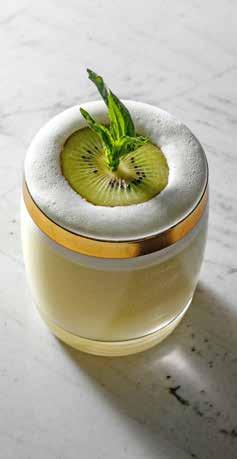
temperature. The sugar will draw out the juices and essential oils from the kiwi, creating a syrup. This process typically takes about 24-48 hours. You can occasionally stir the mixture to help dissolve the sugar and evenly distribute the flavours.
4. Once the sugar has fully dissolved into a syrup and absorbed the kiwi flavours, strain the mixture through a fine mesh sieve or cheesecloth to remove the kiwi solids. Make sure to press the solids to extract as much liquid as possible.
5. Pour the kiwi oleo saccharum into a clean jar or bottle. It can be stored in the refrigerator for a few weeks.
Banana Skin Old Fashioned
Did you know that Fulton, Kentucky was once known as the Banana capital of the world? This delicious banana old fashioned pairs perfectly with the buttery, vanilla notes from a good quality Kentucky straight bourbon!
2 oz bourbon
¼ oz banana oleo saccharum*
2 dashes of Chocolate Bitters
Ice
Orange peel for garnish

1. In a mixing glass, combine the bourbon, banana oleo saccharum, and bitters with ice.
2. Stir well until the mixture is well chilled.
3. Strain the cocktail into a rocks glass over a large ice cube.
4. Garnish with a twist of orange peel to add a citrusy aroma, pairing perfectly with the banana's sweetness.
*Banana Oleo Saccharum
4-5 ripe organic banana skins (ensure there's minimal fruit attached)
1 cup granulated sugar
1. In a bowl, combine the banana peels and sugar. Mash them together slightly to begin releasing the oils from the banana peel.
2. Cover the bowl and let it sit at room temperature for 24-48 hours. The sugar will draw out the oils and moisture from the banana peels, creating a syrupy oleo saccharum.
3. Strain the syrup through a fine mesh sieve, pressing the peels to extract as much liquid as possible. Store the banana oleo saccharum in the refrigerator.
June 2024 | Culinaire 33
Open to any wine, beer, spirits, mead, mixers, sakes, liqueurs, non-alcoholic beverages, and alternatives available to purchase in Alberta
Judged by leading sommeliers, retailers, and media, from across the provinceAlberta palates and experts who know the Alberta market, celebrating 30 years as Canada’s only private liquor market!
No participation medals!
A clean, blind tasting methodology where only the best will rise to the top!
Judges find out what they tasted – only after judging, and receive all their personal tasting notes for future reference
REGISTRATION DEADLINE JUNE 28








DON’T MISS OUT! DON’T MISS OUT! REGISTRATION
28 FOR THE 12TH ANNUAL Alberta Beverage Awards
JUDGING
RESULTS PUBLISHED IN OCTOBER CULINAIRE MAGAZINE
ONLINE AT CULINAIREMAGAZINE.CA/ABA 2024
CLOSES JUNE
JULY 15, 16 ,17
AND
For more information, contact Competition Director Tom Firth: tom@culinairemagazine.ca SHARING
ALBERTANS!
THE BEST BEVERAGES WITH
Beer Styles Getting the Love they Deserve
BY DAVID NUTTALL

As mentioned here last month, beer variety is the main consequence of the growth of craft brewing over the past four-plus decades.
The most prevalent beer of the previous 130 years had been Big Brewery lagers, and while they varied in quality, their domination drowned out all other beer styles except in a few European countries - so much so, that it wasn’t until the publication of Michael Jackson’s The World Guide to Beer in 1977, that most people were even aware of how diverse beer could be. When the Beer Judge Certification Program (BJCP) was founded in 1985, and began publishing their Style Guidelines, it and Jackson’s
books became templates for brewing recipes used by the fledgling craft brewing industry.
The result is a boon to the consumer who loves options. However, not all styles strike a chord with the public, and some experimental beers never get repeated. Others become trendy, join the core lineup of several breweries, and even spread worldwide. So, for those who are looking for lesser-known styles that have become somewhat mainstream with craft brewers, read below.
Each listing has a classic European brand followed by a locally brewed example, so search for them and other imported and craft versions available in Alberta.
Czech (Bohemian) Pilsner/Pils
Originating in the town of Plzeň (Pilsen), Czech Republic (formerly Bohemia), in 1842 by German brewer Josef Groll, Pilsner Urquell (meaning “original source”) is the first true clear pale lager of this style. Even though the name “pilsner” (or pilsener) has now been commandeered and corrupted by breweries the world over, Pilsner Urquell still remains the gold standard over 180 years later.
Its ingredients include light-coloured malts, Saaz hops, lager yeast, and Pilsen’s unique low sulfate and carbonate water that adds to the distinctive hop profile. Beers made in Germany using local noble hops are often called pils.
June 2024 | Culinaire 35



Craft breweries only began producing lagers en masse a few years ago, and this style was one of the first. Clear, crisp, and clean, it has a subtle herbal and spicy bitterness.
Pilsner Urquell (Czech Republic) 388900, $20, 6 pk. bottles
Grizzly Paw Bohemian Pilsner, 828556, $19, 4pk. cans - their use of Saaz hops keeps it close to the original.
Fahr Pils, 823888, $17, 6 pk. canshas a slightly different hop profile from the Czech versions.
Schwarzbier
Ask almost anyone to describe the colour of lager, and they will inevitably say yellow or gold. Lagers can come in any colour the brewer desires, it’s just that light lager monopolizes world brewing. However, one style that seems to have caught on is schwarzbier, also known as black lager or black pilsner. It translates into “black beer” from German and is a more recent addition to craft brewing.
Dark roasted or black malt provides the colour and chocolate/coffee notes, but the use of lager yeasts and noble hops gives it that clean, crisp taste and lighter body, making it different from stouts and porters.
Krombacher Dark Pilsner (Germany), 739174, $18, 6 pk. bottles
Last Best Dirty Bird, 896241, $18, 4pk.
Imperial Stout
Sometimes known as Russian Imperial Stout, so named because, although an English creation, it was a favourite of the
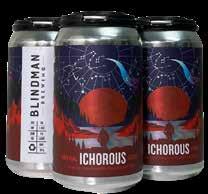
Russian Imperial Court since the late 1700s. An extra strong stout, often hitting 10% ABV and more, it is full of coffee, bitter dark chocolate, and even black licorice flavours.
Big, dark, and malt forward, its rich body hides its true bitterness, making this beer velvety smooth and ideal for sipping. Original versions use English hops and roasted malt, and make excellent candidates for barrel aging. Unlike their other high-alcohol cousin, Barley Wine, imperial stouts tend to be brewed more regularly.
Almost all British versions have dropped out of the Alberta market, but there are several craft versions available.
Samuel Smith Imperial Stout (UK), 7% ABV, 728834, $7, 550 mL bottle
Blindman Ichorous, 11% ABV, 787823, $19, 4 pk. 355 mL cans
Hefeweizen
Wheat ales of various types have been around since craft brewing began. However, the German style hefeweizen (literally meaning “yeast wheat”), consisting of mostly malted wheat fermented with a distinctive weizen yeast, was slow to catch on. The cloudy, highly carbonated version served in a tall glass has been a German staple for over 500 years, and numerous imported versions are available in Alberta today.
The banana and clove nose, and flavour profile are hallmarks of the style. Craft breweries are now embracing hefeweizens as an addition



to their other wheat ales, and dunkel (dark) versions are also popular.
Erdinger Weissbier (Germany) 402230, $6, 500 mL bottle
Fahr Hefeweizen, 823885, $17, 6 pk. cans - this Alberta brewery makes nothing but German style beers.
Saison
First produced in Belgium as a low alcohol pale ale for seasonal (saisonaire) field workers, it is part of what is generally classified as farmhouse ales. The style has grown into a range of colours and alcohol strengths (anywhere from 3-10% ABV).
These beers are dry, highly carbonated, and have a bready maltiness to them. Low in bitterness, it is the yeast that drives the flavour. The family of Saison yeasts produces spicy, peppery, and stone fruit characteristics on the nose and palate.
Versions with added fruit can also be found.
De Ranke Saison De Dottignie (Belgium), 5.5% ABV, 750028, $8, 750 mL bottle
Wild Winds Zephyr Table Saison, 3.5% ABV, 888114, $17, 4pk. cans – a so called “table beer” because of its low alcohol.
XhAle You Can Buy This Beer Unless You Are Anish Kapoor, 5.7% ABV, 871730, $18, 4pk. cans – the addition of blackcurrant puree darkens the colour and adds a jammy tartness.
David has worked in liquor since the late 1980s. He is a freelance writer, beer judge, speaker, and since 2014, has run Brew Ed monthly beer education classes in Calgary. Follow @abfbrewed.
36 Culinaire | June 2024
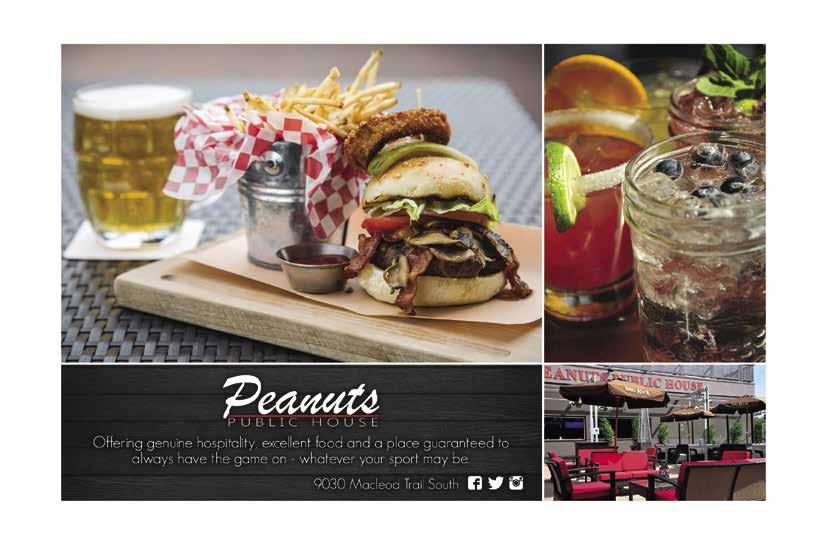
Our 5th Annual
Culinaire Edmonton Treasure Hunt
World Taste Tour is Sunday September 15!
Everyone has gone home a winner at our Culinaire Treasure Hunts and Taste Tours; they’ve been so popular that the spots sell out every year, so now we’ve planned a new and exciting World Taste Tour with new treats to enjoy. And it’s all in one location – just park up and walk, no driving across town!
You’ll answer questions to learn and enjoy different foods at each stop, and use your new knowledge and skill to complete the culinary puzzle to win fabulous prizes! And there are prizes for the best costumes, the funniest team names, the funniest photos on social media... and lots more!
It’s another very fun and rewarding day, so grab a partner and sign up as a team of two, or sign up solo at culinairemagazine.ca/treasure-hunt.
Spots book up fast! Registration is now open!
It’s going to be another day to remember!
@culinairemag /CulinaireMagazine @culinairemag culinairemagazine.ca
5
MAKING THE CASE for Warm Weather Sippers
By TOM FIRTH
Yes indeed, it’s Father’s Day this month and while it’s all too easy to focus on those “Father Faves” like big red wines, whisky of any stripe, or something else rather intense, it came to my mind that this is such a great time to focus on rosé. Wines that are sometimes derided as not too serious, but they are often excellent in quality and taste – and incredible during those hotter days and beautiful Alberta evenings. So here we are, some rosé to start – or finish those days with examples from Canada, Italy, NZ, France, and the US.
One can’t only drink rosé so this month too, I felt it opportune to include another excellent liquid that suits those hotter days - some sake – that can usually be served lightly chilled too. I love learning about sake, and while I have plenty still to learn about it, it’s also an overlooked beverage to just sip and savour too.
Find these wines by searching the CSPC code at Liquorconnect.com; your local liquor store can also use this code to order it for you. Prices are approximate.
Benjamin Bridge Nova 7, Nova Scotia
The sort of unique wine that just makes wine so exciting. Nova 7 – now its 16th vintage from Benjamin Bridge, is definitely off-dry (really - it’s on the sweet side) lightly sparkling, a mild pink in the glass, and made from New York muscat, L’Acadie, and a few others all found in Nova Scotia. Juicy and fresh with sweet characters and sweet fruits, but also some good, balancing acids. A fine alternative to Moscato d’Asti and a perfect encapsulation of summer in a glass.
CSPC 756521 Around $29-32
(Also available in 250mL cans)

Benjamin Bridge 2017 Vintage Brut Rosé, Nova Scotia
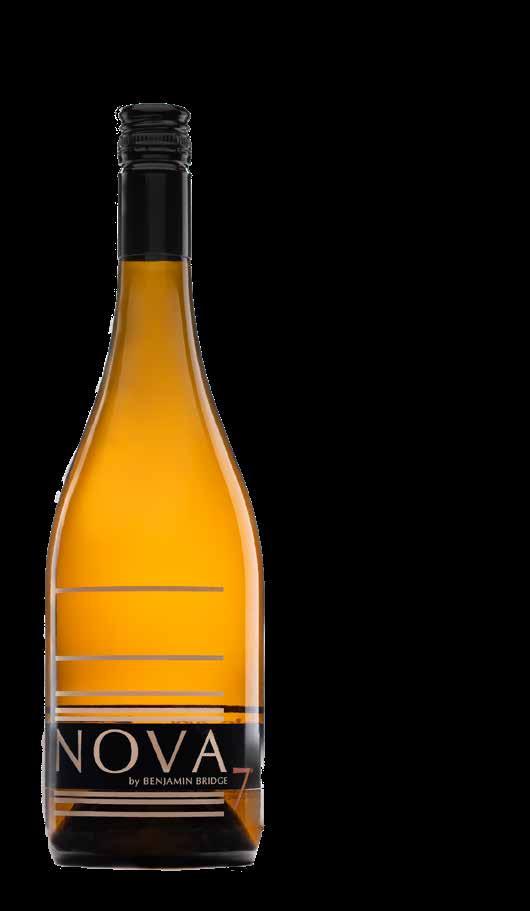
Proof positive that Nova Scotia can make some world-class wines in the Gaspereau Valley. Made from chardonnay and pinot noir, this carries remarkable fruit and mineral with a toastiness that leans towards salted pretzel. Crisp and very dry, this long and graceful glass is one of the best, premium sparkling wines to have on hand for when the need strikes. A stunner.
CSPC 764192 $59-64

Paul Mas 2021 Côté Mas Rosé Aurore South of France
The southern parts of France seem to innately understand the true importance of rosé, and that it often just needs to be enjoyed and not discussed at length. Centred around grenache, syrah, and cinsault, and in a party-friendly 1L bottle, look for a nice balance of sweetness and acids but also plenty of citrus and strawberry fruit. Very easy going, and don’t serve it too cold.
CSPC 813047 $18-21

Nakano Siaka Dai-Ginjo Sake, Japan
Tom has been waxing on (and on) about wine, beer, and spirits for more than 25 years and freelances, consults, and judges on beverages all year long. He is the Managing Editor for Culinaire Magazine, and the Competition Director for the Alberta Beverage Awards.
Dai Ginjo is often the epitome of the brewer’s ability and style in sake production, and a beautiful introduction to quality sake for most. Crisp and clean with an intensity of apple and grapelike fruits leaning towards the tropical spectrum. The palate too carries a fine silkiness and a mild pithiness in the very end. A delicious bottle that should be lightly chilled on its own or with light appetizers.
CSPC 817083 (720mL) $37-39

City
& Country 2021 Similkameen Rosé Alberta
Made in Alberta with grapes direct from the source in the Okanagan, this is a rather crispy rosé with tart fruits of cherry and cranberry, a fine acidity and every so slightly tannic finish. A good match for a hot day, but would also work with those salty snacks or some creamy cheeses. Always a pleasure to enjoy – and so convenient to be able to visit a winery in Calgary too.
CSPC 801273 About $27-31

Bosco de Merlo NV Pinot Grigio Rosé
Veneto, Italy
There are a number of wineries around the world making rosé wines from the white, pinot grigio grape. Soaking the juice on the grape skins makes for a more intense flavour and some of that pinkish colour and a little bit of welcome tannin too. Apple and pear fruits with a lovely floral representation and a lengthy, mildly bitter finish. Very tasty and a fine match with poultry or seafoods.
CSPC 887518 $25-27

Bonterra is almost a by-word for wellcrafted organic and biodynamic wines in California – they’ve been doing it so long and so well that it’s a core part of what they do. Here, this certified organic, grenache-based wine carries a vivacious and friendly berry fruit that is quite dry on the palate but buffered by zippy acids. A wine for sipping and enjoying and less for talking about – a sunset sipper for those hot days.
CSPC 815933 $20-23

Mouton Cadet 2022 Rosé, Bordeaux France
Well known in Alberta for decades of quality at a stellar price, its been more than a handful of years since I last tried it. Very pale in the glass with a lemony aroma supported by mild, red berry fruits and a clean, floral character. Light and almost breezy on the palate with a bare smidgeon of sweetness, but crisp acids that seem to beckon for lighter seafood dishes – or salty snacks.
CSPC 865708 $17-20

Mount Riley 2022 “The Bonnie” Pinot Rosé, Marlborough, New Zealand
A blend of pinot gris and pinot noir, and more importantly, striking the right balance between white, peachy/apple fruit and red berries like strawberry and cherry. Quite dry, yet it feels sweeter and rather juicy coming together in a fine package with zesty acids, bright floral characters, and those lovely fruits. Very, very easy to enjoy especially the raspberry jelly notes at the finish.
CSPC 880858 $20-23

Chiaretto Valtenesi NV Rosé Classico Riviera del Garda, Italy
Centred around groppelo grapes with barbera, sangiovese, and marzemino, the expression here is rather juicy with plump berry fruits of currant, plum and a bit of cranberry and gooseberry. Crisp and dry, it shows off a little with a slightly bitter, nutty finish and good wallop of appropriate spiciness. A pleasure to drink, it would be a hit with charcuterie or some salty snacks too.
CSPC 839006 $25-28

La Vieille Ferme 2022 Rosé, Ventoux France
Another, classic, well priced French label, La Vieille Ferme hit the shelves in Alberta back in the 1990’s and was an instant sensation – the price was pretty amazing at the time. Brightly floral on the nose with a slightly mineral and cherry-driven character, it’s in the mouth that it really comes together with a very dry profile but a lengthy, juicy fruit finish. A summer quaffer for sure.
CSPC 1217137 $15-17


A perfectly refreshing example of a sake suitable for novices to the style and longtime enthusiasts looking for a lighter expression. Light fruits, a touch of dried mushroom and a mild bready character that might be most similar to hot cross buns (sans icing) to many Canadians. Very well balanced and while delightful on its own, would complement mild creamy sauces, light seafoods, or good, soft cheese.
CSPC 794511 (720mL) $22-25
Another beautiful French rosé to share, and one utilizing those grapes we love from the hotter parts of France. Grenache, cinsault, mourvèdre, and syrah come together with a rather peachy fruit presence, but also crushed strawberries and a hint of spice too. Bright and pretty in the mouth with fine balance and a nice long finish. No food required, but this will stun with creamy cheese on the charcuterie board.
CSPC 889408 $32-35
June 2024 | Culinaire 39
Bertrand Côte de Roses NV Rosé, Languedoc, France
Yoshi No Gawa Honjozo Sake, Japan
Bonterra 2023 Rosé, California
Wonderful Pistachios No Shells
Jalapeño Lime
Uh oh… I sense a new addiction!
Wonderful Pistachios have added a new flavour to their ‘No Shells’ range in Canada. In addition to their five existing flavours, they’ve introduced Jalepeño Lime. We’d call them ‘tangy’ rather than spicy, and there’s a lovely, gentle, little warmth on the back of your throat from the jalapeños, that’s not hot for those that can’t tolerate spice. High protein and high fibre, non-GMO, gluten-free, halal, and kosher – and as well as for snacking, there are recipes at wonderfulpistachios.com. 155 g $7-10
Weber 17” Portable Griddle
Who doesn’t love finding something that fills a need you didn’t know wasn’t being met? We had the chance to try out a pretty fantastic portable griddle from Weber that is sure to up the “A” game for outdoor entertaining. Although it also comes in a 22” size, we tested out the 17” model – and that is the width, not the diagonal dimension - it’s bigger than you think. About 25 kg, it’s also heavier than you think – so those far-out backcountry trips with the griddle might be a little much for those arms. But most of that is the very sturdy griddle component, which is what you want for even heat and fast cooking. After seasoning the griddle (incredibly important), it’s capable of getting quite hot for all that searing, but also with good temperature control too for a range of dishes and occasions – like breakfast or brunch – but also for a range of cuisines or classic dishes. While it does function as a “barbecue” quite well, it’s as
Fever-Tree Sparkling
Sicilian Lemonade
In perfect time for summer, Fever-Tree has brought out a new flavour of mixer - Sparkling Sicilian Lemonade. The oils are extracted from both the peel and the juice using a process normally only used by perfumiers, to give a beautifully balanced, bright and zesty tartness with fine bubbles. We really enjoyed it with bourbon and basil – muddling the basil in an ice-filled glass and adding 3:1 Sicilian Lemonade to bourbon. Cheers!


a griddle you’ll that you will really enjoy it and find it nearly essential for backyard entertaining, family gatherings at home or nearby such as at the park or for tailgating, even for the RV and camping trailer set. Very well made, very handy, and with great utility too. $350
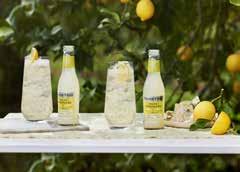
Widely available, 4 x 200 mL bottles
$6-8

Cowboy Cocktails
Sure, some folks ‘round these parts are true, dyed in the wool cowboys, while others might save the boots and hats for the summertime rodeos and beer halls. For yet some others, we might also like to only get so “down ‘n dirty”. Author André Darlington has compiled 60 western themed cocktails (and a few dishes too) that might elevate your next summer cookout. Sure the theme is around the “American West”, but we know the true west is here - right? $26 Epic Ink
Natrel Coffee Creamers


Natrel, from Quebec, have added a new line of coffee creamers to their range of dairy products. The natural, low-fat creamers come in three delicious flavours; we loved the rich hazelnut, but we also liked the natural flavouring and the balance of sweetness of the vanilla and the caramel. The creamers are less sweet than some, and they’re made from 100 percent Canadian milk and cream (no palm or vegetable oils!), which gives a terrific foam. Widely available in 1 litre packs, around $6-7, they are bound to add a little sweetness to your morning.
40 Culinaire | June 2024
etcetera...







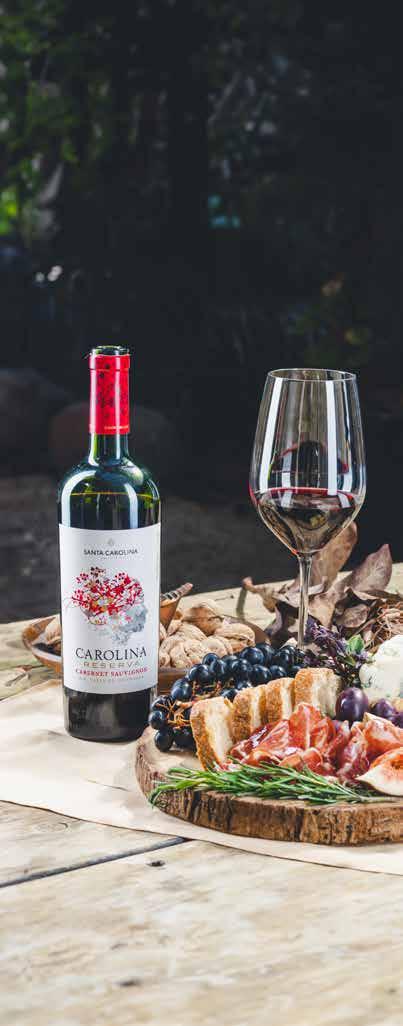

Heritage always leaves a trace. Over 120 years of winemaking tradition. One Family. The same passion. BUY HERE ENJOY RESPONSIBLY CREATE UNIQUE MOMENTS FULL OF INSPIRATION
...with Sky McLean
BY LINDA GARSON AND QUINN CURTIS
ou always hear, don't do food and beverage, and I was like, we're never doing food and beverage. And then here we are doing food and beverage, and I love it now,” says Sky McLean. Growing up in the suburbs of Richmond Hill, Ontario, McLean never pictured herself as a restaurant owner/entrepreneur. After achieving her MBA in real estate from York University, McLean purchased her first-ever property, a Canmore condo, which inspired her beginnings in the hospitality business.
The zoning laws on her condo meant that McLean could rent out her place as an Airbnb when she wasn’t using it. “I decided when I was gone for the weekends - skiing, climbing, biking, I'd put it on Airbnb and try to make a couple bucks. Well holy, it was really lucrative,” she says. So she didn't stop there… “I had no exposure to hotels. I couldn't even afford to stay in one at the time. So I got a loan and bought another condo that had nightly rental zoning. And now I had two.”
McLean met her husband Tim, who was a carpenter, and when she was let go from her job, it was the push she needed to break into the hospitality business. “I have these two mortgages and we're screwed,” she laughs. “There was no way to support this situation. But these two condos are such a good little business, why not have 32 of them?” McLean worked to raise money from investors and built the first Basecamp Resorts in Canmore. “Tim did the construction, and I did all the development and project.” And on August 1st, 2017, the property opened to the public.
There were other hotels for sale and

the market was hot, and with Canmore getting on the map, McLean was ready to raise more money and do more deals, resulting in five more properties and an expansion into Revelstoke, BC. “We opened Basecamp Lodge and Lamphouse Hotel on the same weekend in 2018. And I'll never forget that, it was my birthday weekend and I was pregnant with my first kid, Madison, and we opened these two hotels, and then at the same time we started Basecamp Resorts Revelstoke, as well as Basecamp Suites, Canmore,” she says. “It was fun, and it was stressful.”
McLean’s first restaurant, Rhythm and Howl, is inside Mountain House, her new premium Canmore property. While she has a passion for good food and good drinks, she never saw herself as owning a restaurant. “It's different if you're a foodie or a restaurateur or a chef, but here I am getting into arguably one of the hardest businesses and survive as someone who knows nothing about it other than how to consume it,” says McLean. “And a restaurant in a hotel is also very different than a restaurant on Main Street,” she adds. “We’re trying to get people into a hotel lobby.”
So they hired good people, successful consultants such as Native Tongues’ Cody Willis and Adam Gill from Una, along with operations manager, Dave Jones, Chef Jason Leizert, and GM Brent Seetaram. “I love it,” she says. “Now, we’re not going to open a million more restaurants, but we're going to have more for sure – in the right location, in the right hotel. Hotels and restaurants go together, and we’re going to definitely do it again.”
So, what is the bottle that McLean is going to be opening on her next special occasion? The bottle of Painted Rock Cabernet Franc was given to her by Dave Jones, who knows what kind of wine she likes better than she does. “I think the reason that this wine is really special is not just because it's going to be good, and I love Cab Franc - that's my favourite grape - but because it came from Dave who had a huge influence on the restaurant and knows exactly what I like. To me, a bottle's even more special if there’s sentimental attachment,” she says. “Because for me at Basecamp, everything is really about the team.” And when might McLean open that bottle? She just turned 40 and it’s the start of her birthday month!
42 Culinaire | June 2024
OPEN THAT BOTTLE
"Y
Courtesy Basecamp Resorts

MODERN STEAK
Catch the Rooftop Vibe
Catch the Rooftop Vibe Catch the Rooftop Vibe
LUNCH |
HAPPY HOUR
|
DINNER
S T E P H E N A V E N U E
W W W . M O D E R N S T E A K . C A

July 18-28, 2024
Churchill Square
 ALBERTA / FOOD & DRINK / RECIPES JUNE 2024
The Buzz about Bourbon | Dinner for Dad | Belgian Beer | Edible Flowers
ALBERTA / FOOD & DRINK / RECIPES JUNE 2024
The Buzz about Bourbon | Dinner for Dad | Belgian Beer | Edible Flowers












 Laphroaig® 10 Year Old Single Malt Scotch Whisky, 43% alc/vol. ©2024 Laphroaig Import Company, Chicago, IL
Laphroaig® 10 Year Old Single Malt Scotch Whisky, 43% alc/vol. ©2024 Laphroaig Import Company, Chicago, IL










































































 WBY TOM FIRTH AND LINDA GARSON
WBY TOM FIRTH AND LINDA GARSON




















































